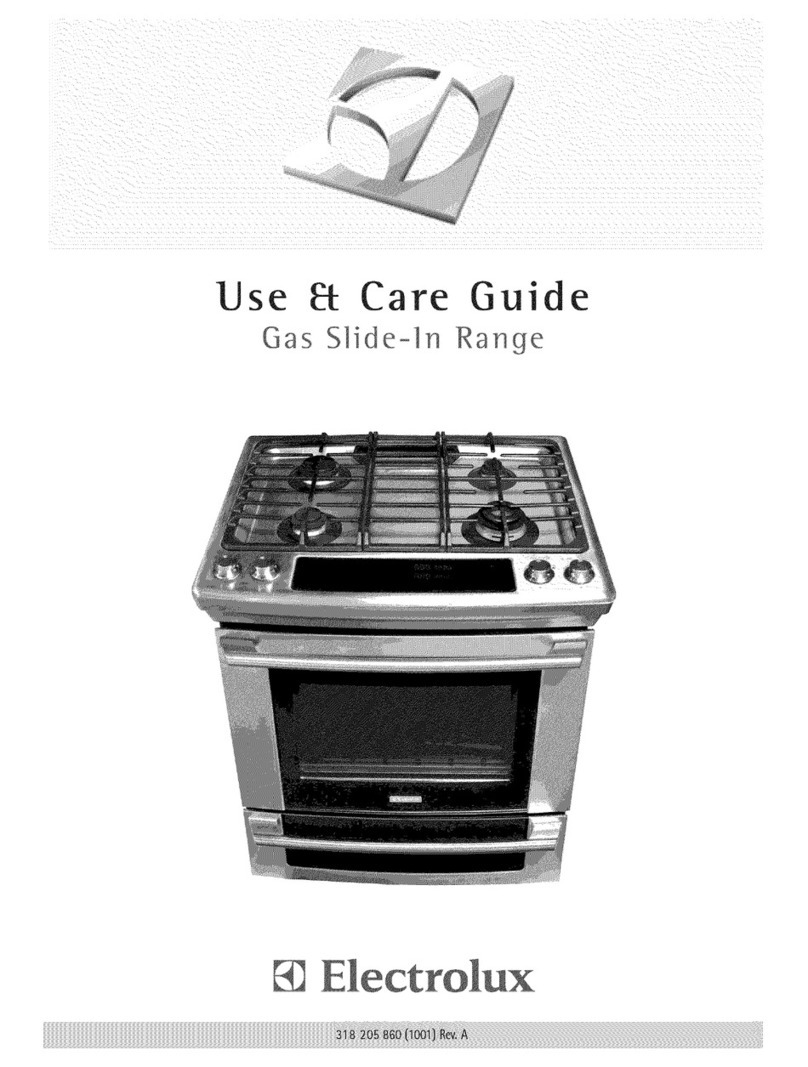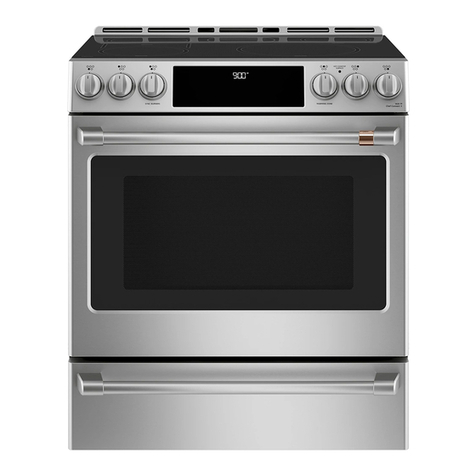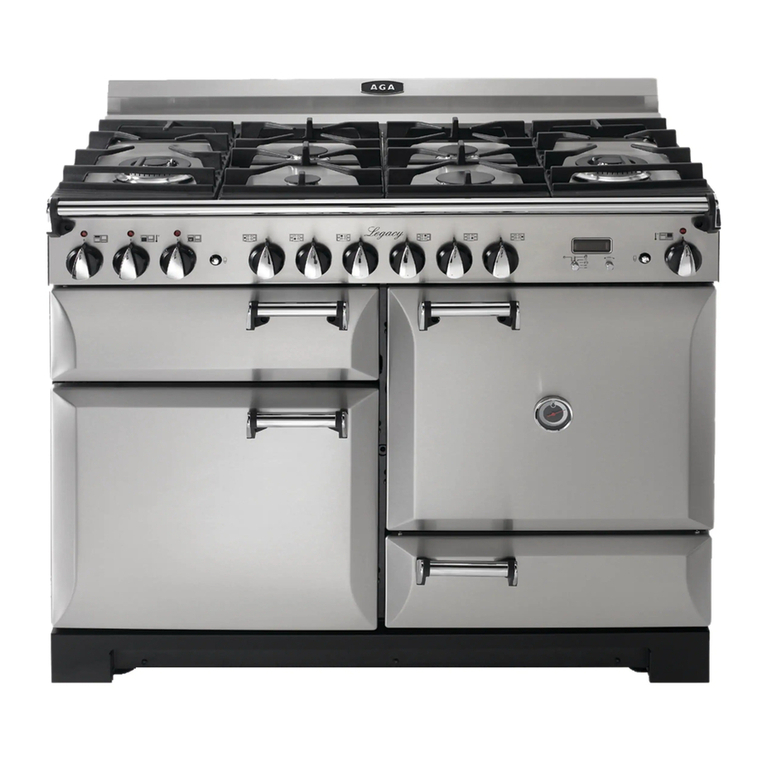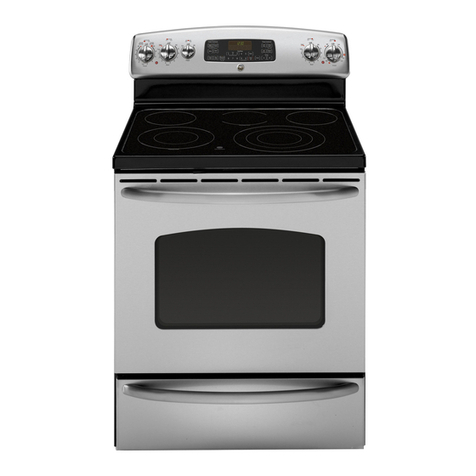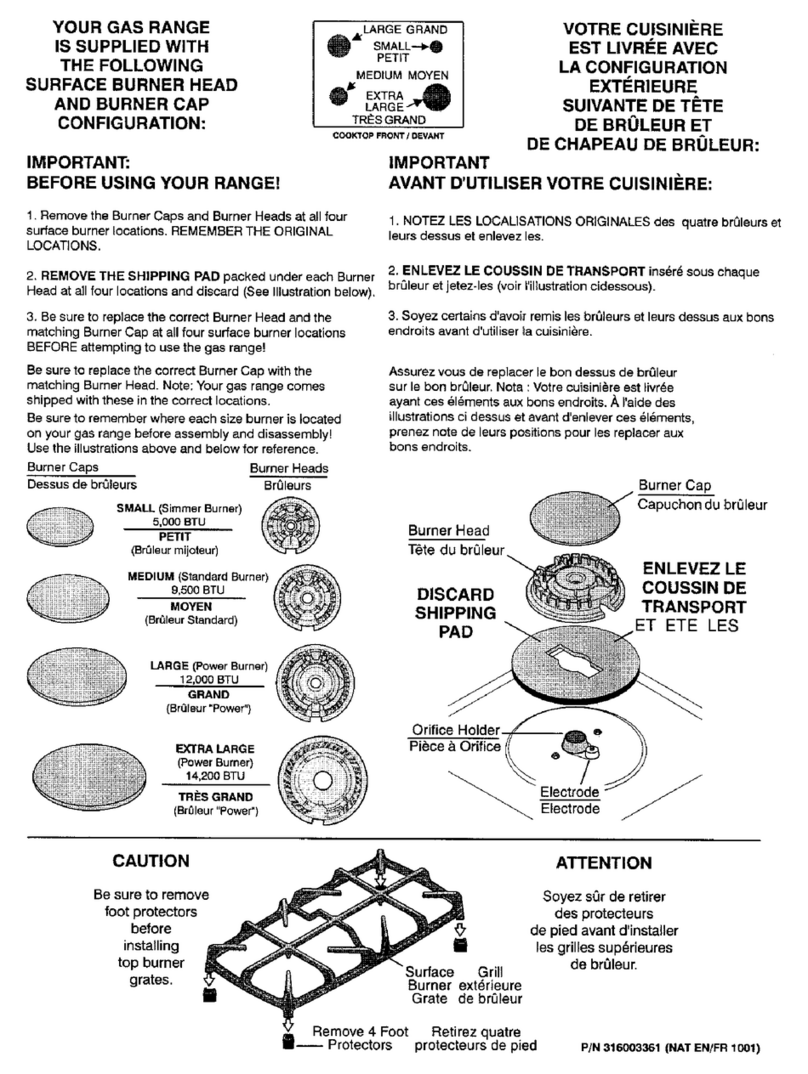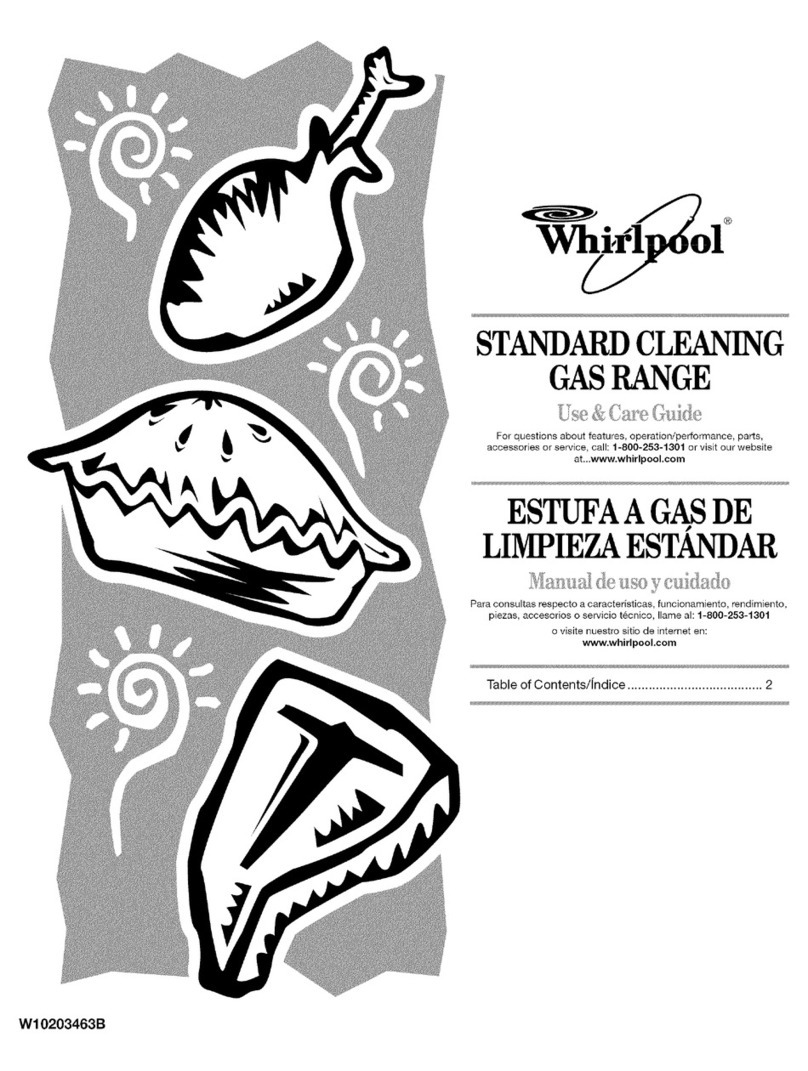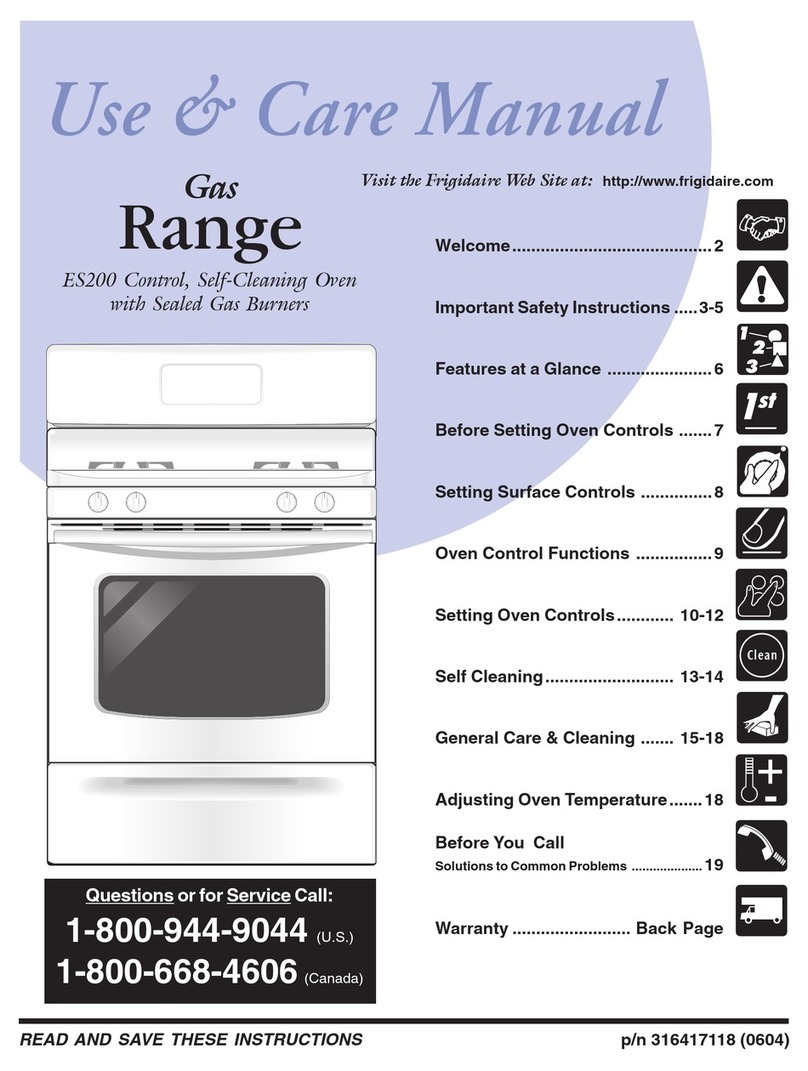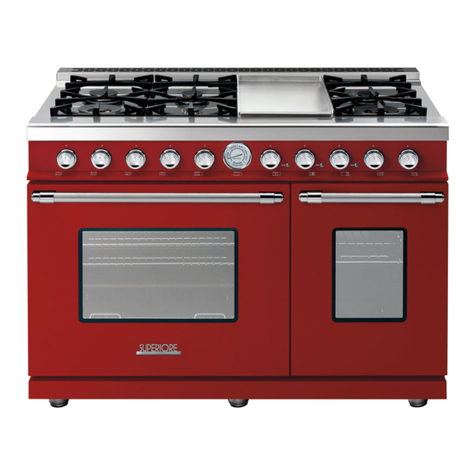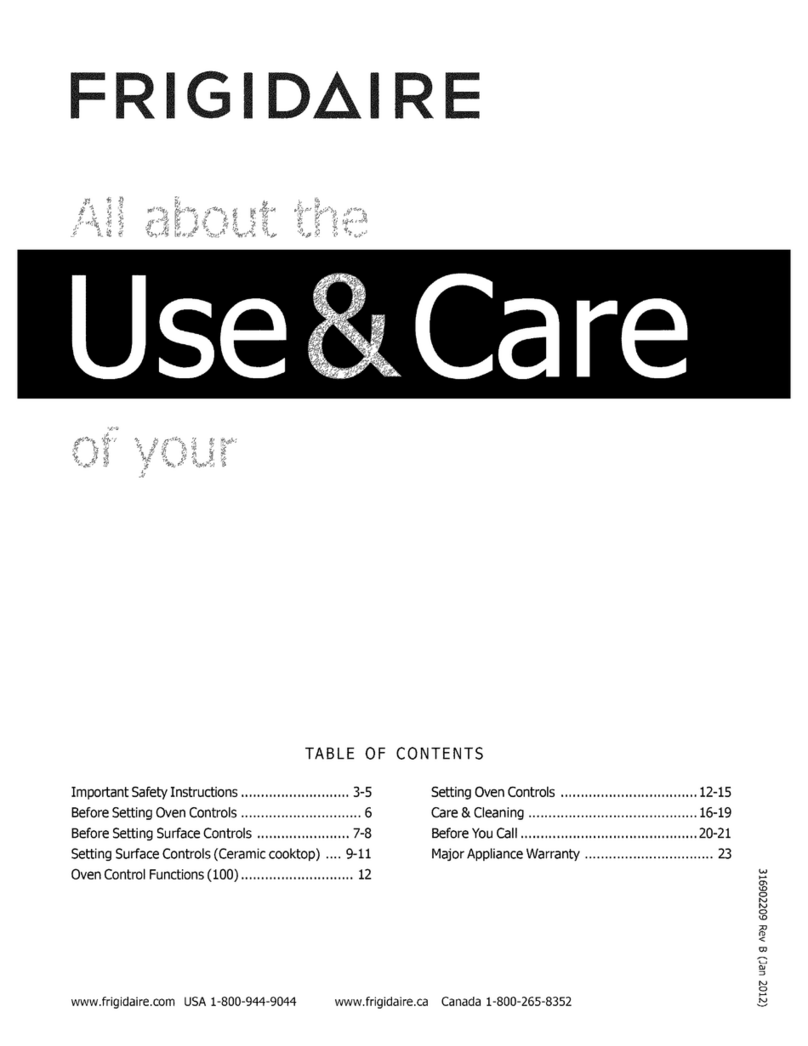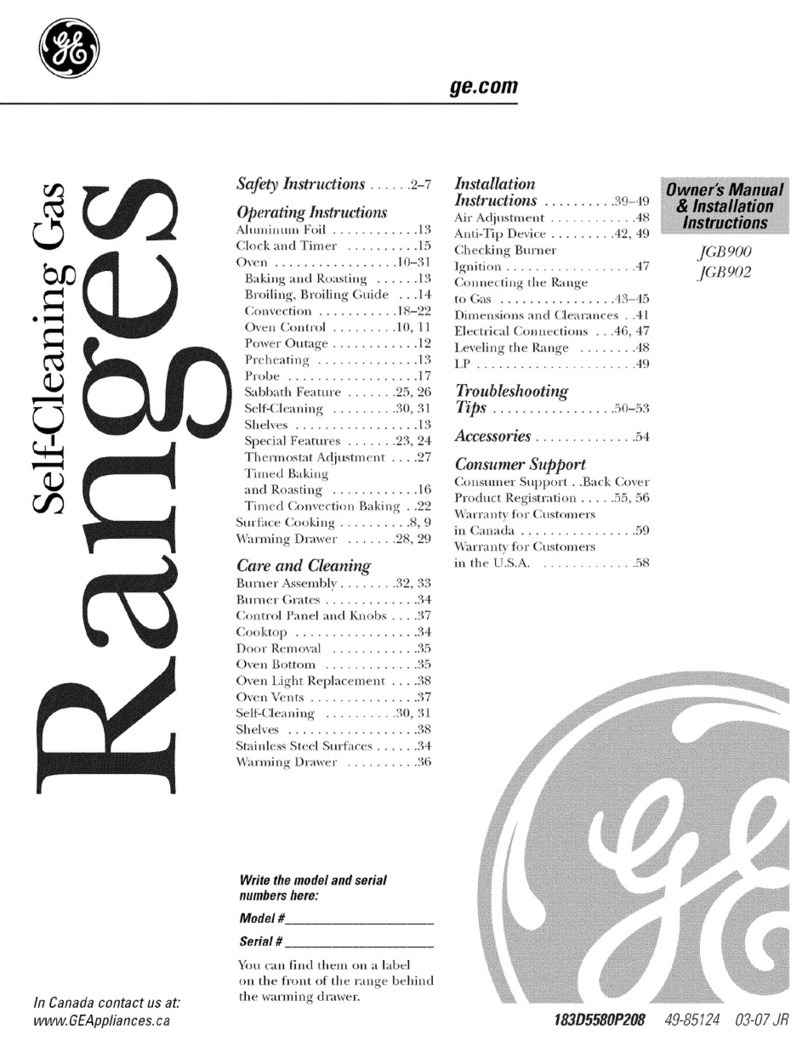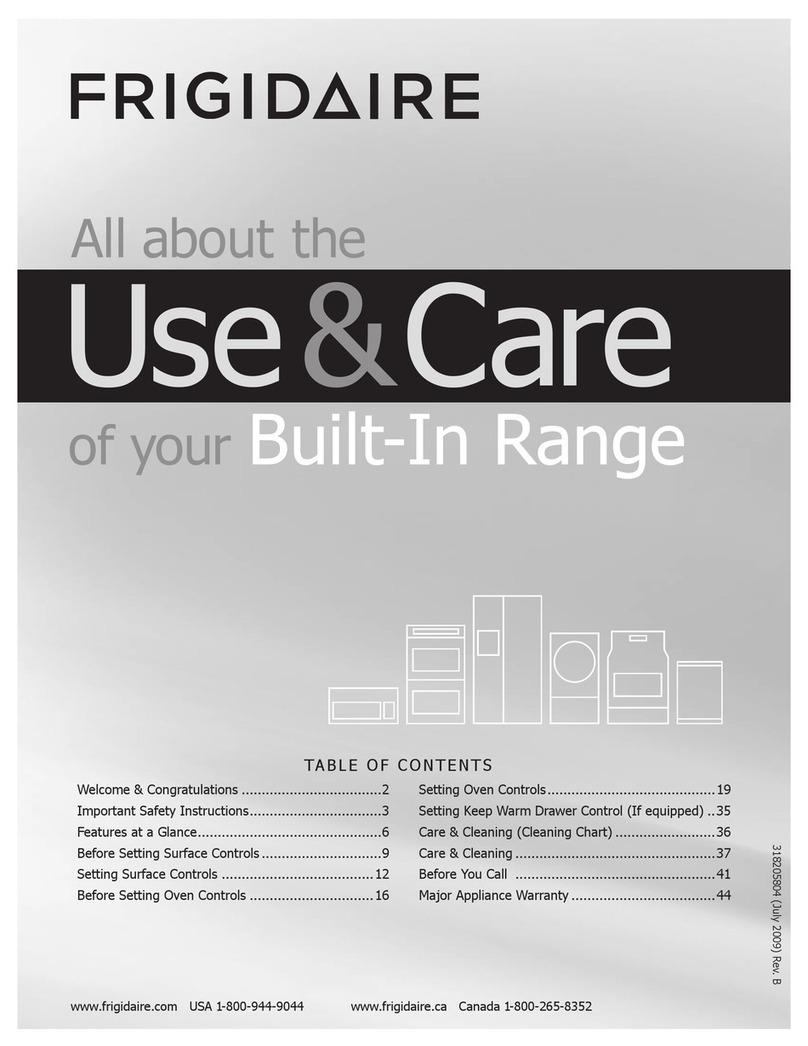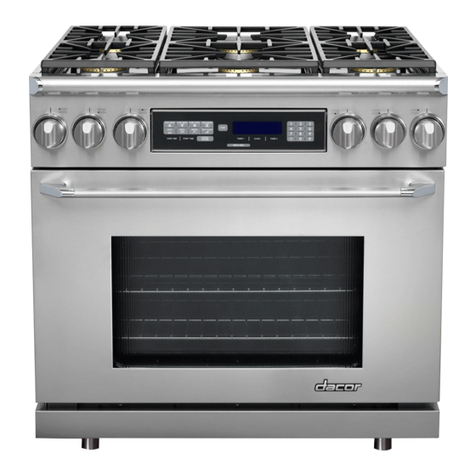Baron 700 Series Operating and maintenance manual

Data Emissione 09/09/2003 Revisione 0.0
- 1 -
SERIE 700 / 900
IT Cucine a gas Pag. 2
DE Allgas Herde Pag. 7
GB Gas ranges Pag. 13
FR Cuisinieres a gaz Pag. 18
NL Gaskeukens Pag. 23. 23
DK Gaskomfur Pag. 28
DK Gaskomfur Pag. 28
AVVERTENZE D’INSTALLAZIONE USO E MANUTENZIONE
AUFSTELLUNG, GEBRAUCHS- UND INSTANDHALTUNGS ANWEISUNGEN.
INSTRUCTION FOR INSTALLATION, ADJUSTEMENT, USE AND MAINTENANCE
NOTICES D' INSTALLATION, DE REGLAGE, D'EMPLOI ET D'ENTRETIEN
AANWIJZINGEN VOOR DE INSTALLATIE, HET GEBRUIK EN HET ONDERHOUD.
INSTALLATION - VEDLIGEHOLDELSES - OG BRUGSVEJLEDNING
Cod. 827730020

Data Emissione 09/09/2003 Revisione 0.0
INDICE
1 - ISTRUZIONI PER L' INSTALLAZIONE pag. 3
1.1 Identificazione modelli pag. 3
1.2 Dati tecnici pag .3
2 - AVVERTENZE GENERALI pag. 3
2.1 Installazione pag. 3
2.2 Montaggio pag. 3
2.3 Montaggio top su base neutra pag. 3
2.4 Unione tra apparecchiature pag. 3
2.5 Montaggio top a ponte pag. 3
2.6 Collegamento alla rete alimentazione gas pag. 3
2.7 Collegamenti elettrici (per apparecchi con accensione elettrica fuochi) pag. 4
2.8 Collegamenti equipotenziali (per apparecchi con accens.elettr. fuochi) pag. 4
3 - TRASFORMAZIONE PER ADATTAMENTO AD ALTRI TIPI DI GAS pag. 4
3.1 Sostituzione ugelli bruciatore pilota piano cottura. pag. 4
3.2 Sostituzione ugelli e regolaz.aria bruciatori piano cottura pag. 4
3.3 Sostituzione ugello del minimo piano di cottura pag. 4
3.4 Sostituzione ugello bruciatore pilota forno gas pag. 4
3.5 Sostituzione ugello e regol. aria bruciatore forno gas pag. 4
3.6 Sostituzione targhetta caratteristiche gas pag. 4
4 - MESSA IN FUNZIONE pag. 4
4.1 Controllo funzionamento impianto gas pag. 4
4.2 Controllo della potenza termica pag. 4
4.3 Controllo della pressione di alimentazione gas pag. 4
5 - ESAME DI ALCUNI MALFUNZIONAMENTI pag. 5
5.1 Difficile o mancata accensione bruciatore pilota pag. 5
5.1a Difficile o mancata accens. bruc. pilota per apparecchi con acc. elettrica pag. 5
5.2 Spegnimento bruciatore pilota durante il funzionamento pag. 5
5.3 Difficile o mancata accensione bruciatore pag. 5
5.4 Difficile regolazione della temperatura forno pag. 5
6 - SOSTITUZIONE DI ALCUNI COMPONENTI pag. 5
Bruciatori piano cottura - Bruciatore pilota - Candelina
Termocoppia - Trasformatore accensione- Cavi alta tensione- Pulsante accensione
Bruciatore forno - Rubinetto gas piano di cottura - Valvola gas forno
Accenditore piezoelettrico forno.
7.1 AVVERTENZE pag. 5
7.2 Utilizzazione piano di cottura pag. 5
7.3 Accensione bruciatori piano di cottura pag. 5
7.3a Accensione bruciatori piano di cottura con accensione elettrica pag. 6
7.4 Spegnimento bruciatori del piano di cottura pag. 6
7.5 Utilizzazione forno a gas pag. 6
7.6 Accensione bruciatore forno a gas pag. 6
7.7 Spegnimento bruciatore forno a gas pag. 6
8 - PULIZIA E MANUTENZIONE pag. 6
9 - ELENCO PARTI DI RICAMBIO pag. 6
10 - ALLEGATI pag. 33
2

Data Emissione 09/09/2003 Revisione 0.0
1- ISTRUZIONI PER L' INSTALLAZIONE
1.1 Identificazione modelli SERIE 700 SERIE 900
Modelli con
accensione manuale
dei fuochi aperti
Modelli con
accensione elettrica
dei fuochi aperti
Modelli con
accensione manuale
dei fuochi aperti
Modelli con
accensione elettrica
dei fuochi aperti
4 fuochi gas con forno gas 803131141 803131341 803141141 803141341
6 fuochi gas con forno gas 803131161 803131361 803141161 803141361
8 fuochi gas con forno gas 803131181 803131381 803141181 803141381
2 fuochi gas con vano aperto 803111121 803111321 803121121 803121321
4 fuochi gas con vano aperto 803111141 803111341 803121141 803121341
6 fuochi gas con vano aperto 803111161 803111361 803121161 803121361
8 fuochi gas con vano aperto 803111181 803111381 803121181 803121381
2 fuochi gas “top” 803151121 803151321 803161121 803161321
4 fuochi gas “top” 803151141 803151341 803161141 803161341
6 fuochi gas “top” 803151161 803151361 803161161 803161361
8 fuochi gas “top” 803151181 803151381 803161181 803161381
1.2 Dati tecnici
I dati tecnici delle apparecchiature sono riportati nelle Tabelle T5 -
T5A - T6 - T6A
2 - AVVERTENZE
Leggere attentamente le avvertenze contenute nel presente libretto
in quanto forniscono importanti indicazioni riguardanti la sicurezza
d’installazione di uso e di manutenzione. Conservare con cura
questo libretto per ogni ulteriore consultazione dei vari operatori.
L'installazione, la trasformazione e la manutenzione
dell'apparecchio devono essere effettuati da Installatori autorizzati o
da Enti in modo conforme alle normative di sicurezza in vigore.
Il Costruttore declina ogni responsabilità in caso di mancato
rispetto di tale obbligo
Nota - Le apparecchiature sono conformi alla Norma CEI 61-50
2.1 Installazione
- Dopo aver tolto l’ imballaggio assicurarsi dell’ integrità della
apparecchiatura. In caso dubbio non utilizzare la stessa e
rivolgersi a personale professionalmente qualificato.
- Gli elementi d’imballaggio non devono essere lasciati alla portata
di bambini in quanto potenzialmente fonti di pericolo.
- L’apparecchiatura dev’essere sistemata nella posizione definitiva
che occuperà in cucina e preferibilmente sotto cappa
d’aspirazione atta a permettere una buona rigenerazione d’ aria.
- L'installazione dev’essere effettuata solo in locali sufficientemente
aerati.
- Le apparecchiature di tipo A1 possono essere installate solo in
locali ventilati in conformità ai regolamenti tecnici in vigore. E'
sempre consigliabile posizionarle sotto cappa di aspirazione che
assicuri l'estrazione dei vapori e dei gas della combustione.
- Il tipo di installazione eseguito deve essere evidenziato
apponendo una crocetta nella casella interessata: A1-B11-B21
sulla targhetta caratteristiche (posta all’ interno del cruscotto
comandi).
- Le apparecchiature possono essere installate separatamente
oppure composte con altre apparecchiature della nostra gamma.
- L’apparecchiatura non è adatta per l’incasso.
- La distanza dell’ apparecchiatura dalle pareti circostanti
dev’essere almeno di 10 cm. In presenza di pareti incombustibili o
protette da isolamento termico tale distanza può essere ridotta.
- Le dimensioni di ingombro delle apparecchiature sono riportati
nelle pagine allegate.
2.2Montaggio
- Togliere la pellicola protettiva dalle pareti esterne dell'apparecchio
Il collante che può eventualmente rimanere sulle pareti va tolto
con un solvente appropriato.
- Procedere alla messa in piano dell'apparecchiatura agendo sui
piedini regolabili.
- L'apparecchiatura di larghezza 40 cm installata singolarmente
dev’essere fissata al pavimento utilizzando le apposite flange.Fig.
2A.
2.3 Montaggio del top su base neutra Fig. 3
- Per eseguire il montaggio del "top" con la relativa base neutra
occorre:
- Rimuovere le manopole, il pannello comandi e lo schienale del
top.
- Posizionare il top sulla relativa base.
- Fissare le due apparecchiature tramite le 4 viti V come indicato in
fig.3.
- Rimontare il pannello comando e lo schienale del top.
2.4 Unione in linea delle apparecchiature Fig. 2
Procedere come segue:
- Rimuovere le manopole ed il pannello comandi del top.
- Accostare le apparecchiature e livellarle alla medesima altezza.
- Fissarle con le apposite viti come indicato in Fig. 2.
2.5 Montaggio apparecchiature top a ponte fig. 3A
- Fissare le due traverse di sostegno T utilizzando gli appositi fori
previsti sui fianchi delle apparecchiature contigue di sostegno.
- Livellare accuratamente le due apparecchiature di sostegno.
- Posizionare il top sulle traverse e rimuovere, dallo stesso, le
manopole ed il pannello.
- Fissare il top alle traverse con le 4 viti V come indicato in figura 3.
- Eseguire il fissaggio con le apparecchiature affiancate come
indicato al punto 2.4 fig.2 -Rimontare lo schienale, il pannello
comandi e le manopole del top.
2.6 Collegamento alla rete alimentazione gas
- Prima d’effettuare il collegamento dev’essere consultato l'Ente
d’erogazione del gas- Installare, a monte dell' apparecchio, in
posizione facilmente accessibile, un rubinetto d'intercettazione.
- Verificare l'assenza di perdite nei punti di collegamento.
- Se previsto il collegamento posteriore rimuovere il tappo di
chiusura e montarlo a tenuta sull'attacco anteriore.
3

Data Emissione 09/09/2003 Revisione 0.0
Verificare la predisposizione dell'apparecchio al gas
d’alimentazione, se necessario procedere all'adattamento al tipo
di gas erogato solo dopo attenta lettura del paragrafo 3.
- Per installazione di apparecchi in Danimarca occorre avvitare
sulla rampa d’alimentazione il nipplo fornito in dotazione prima
d’eseguire l'allacciamento alla rete d’erogazione gas.
2.7 Collegamenti elettrici (Per le cucine con accensione elettrica dei
fuochi)
L’apparecchiatura è predisposta per funzionare alla tensione
indicata sulla targhetta, è ammessa una variazione del + 10%.
Ogni apparecchiatura dev’essere alimentata con una linea elettrica
indipendente opportunamente dimensionata. Il collegamento
dev’essere realizzato sull’ apposita morsettiera d’arrivo linea con un
cavo flessibile sotto guaina in gomma H05RN-F, protetto da tubo
metallico o di materiale plastico rigido. E’ necessario installare
appositi interruttori automatici di protezione, di portata adeguata,
con una apertura dei contatti di almeno 3 mm e dispositivi di
protezione contro il contatto diretto e indiretto delle parti in tensione
e delle correnti di guasto verso terra, secondo le norme (massima
corrente di dispersione ammessa 1 mA/kW).
2.8 Collegamento di terra ed equipotenziale (Per le cucine con
accensione elettrica dei fuochi)
E’necessario collegare a terra l’apparecchiatura sul morsetto
contraddistinto dal simbolo posto sulla morsettiera d’arrivo
linea.
Collegare inoltre la struttura metallica di tutte le apparecchiature
elettriche installate, sul morsetto contraddistinto con il simbolo
(collegamento equipotenziale)
3 - TRASFORMAZIONE PER ADATTAMENTO AD ALTRI TIPI DI
GAS
Qualora il tipo di gas erogato non corrisponda a quello per cui è
predisposto l'apparecchio devono essere effettuate tutte le
operazioni qui elencate.
Gli ugelli e le targhette caratteristiche sono contenute in un apposito
sacchetto di cui l'apparecchiatura è dotata.
3.1 Sostituzione ugelli bruciatori pilota piano di cottura (Fig.4 )
- Rimuovere la griglia posategami, lo spartifiamma ed il corpo del
bruciatore. Togliere le due viti che fissano il bruciatore pilota alla
piastrina di sostegno e sollevarlo.
a)Svitare il raccordo R e sostituire l'ugello UP con quello indicato
nella tabella T1.
b)Riavvitare il raccordo R.
Rimontare il tutto agendo in ordine inverso.
3.2 Sostituzione ugelli e regolazione aria bruciatori piano di cottura
(Fig.5)
- Rimuovere le manopole ed il pannello comandi.
- Svitare l'ugello Upresente e sostituirlo con quello indicato nella
tabella T1.
- Allentare la vite V e regolare la boccola di regolazione dell' aria
alla distanza "A" indicata nella tabella T1.
- Riavvitare la vite Va fondo e sigillarla con vernice rossa.
3.3 Sostituzione dell' ugello del minimo del piano di cottura fig.1
- Rimuovere le manopole ed il pannello comandi.
- Svitare la vite del minimo VM dal rubinetto e sostituirla con quella
indicata nella tabella T1.
3.4 Sostituzione ugelli bruciatori pilota forno a gas (Fig. 4 )
- Rimuovere il pannello orizzontale inferiore.
- Svitare il raccordo R e sostituire l'ugello UP con quello indicato
nella tabella T1.
- Riavvitare il raccordo R.
3.5 Sostituzione ugelli e regolazione aria bruciatori forno gas(fig.5A)
- Rimuovere il pannello orizzontale inferiore e la suola forno.
- Svitare l'ugello Upresente e sostituirlo con quello indicato nella tabella
T1.
- Allentare le viti V e posizionare la regolazione dell' aria alla
distanza "A" indicata nella tabella T1.
- Riavvitare le viti Va fondo e sigillarle con vernice rossa.
3.6 Sostituzione targhetta predisposizione gas
- Applicare sull’ apparecchiatura la targhetta che indica il nuovo tipo
di gas per il quale è stata eseguita la trasformazione.
4 - MESSA IN FUNZIONE
4.1 Controllo del funzionamento
Avviare l'apparecchio secondo le istruzioni d'uso e verificare :
- il corretto funzionamento dei bruciatori pilota e principali
- l’ assenza di perdite di gas.
- la funzionalità dei sistemi d’aerazione del locale.
- l'efficacia dell' impianto di scarico dei gas combusti se necessario
consultare il paragrafo 5 "Esame di alcuni malfunzionamenti "
- la corrispondenza dei dati di targa con quelli delle reti di
distribuzione elettrica e del gas.
Avvertenza: durante il funzionamento prestare la massima
attenzione alle zone calde della superficie esterna
4.2 Controllo della potenza termica
Eseguita l'installazione e dopo la trasformazione ad altro tipo di gas
ed in caso d’interventi di manutenzione occorre controllare la
potenza termica dell' apparecchiatura.
- La potenza termica nominale è indicata nelle tabelle T5 - T5A - T6
- T6A.
-L' apparecchiatura funziona al valore nominale quando gli ugelli
montati sono adeguati al tipo di gas d’alimentazione ed alla
pressione d’esercizio indicata nella tabella T1.
- Per il controllo della pressione d’alimentazione consultare il
paragrafo 4.3 "Controllo della pressione di alimentazione gas"
4.3 Controllo della pressione d’alimentazione del gas
- Lo strumento di misura richiesto è il manometro con definizione
minima di 0,2 mbar
- Rimuovere le manopole ed il pannello comandi del piano di
cottura.
- Togliere la vite di tenuta della presa di pressione P (fig. 1) e
collegarvi il tubo del manometro.
- Effettuare la misura con l'apparecchio in funzione
- Il valore misurato deve rientrare nei limiti indicati nella tabella T3,
in caso contrario interrompere la prova e contattare l' Ente
d’erogazione del gas.
- Scollegare il tubo del manometro ed avvitare a fondo la vite di
presa pressione.
4

Data Emissione 09/09/2003 Revisione 0.0
5 - ESAME DI ALCUNI MALFUNZIONAMENTI
5.1 Difficile o mancata accensione bruciatore pilota
- Pressione del gas d’alimentazione insufficiente.
- Ugello o conduttura ostruiti.
- Rubinetto gas difettoso o valvola gas forno difettosa.
- Accenditore piezoelettrico o cavo accensione forno difettosi
5.1a Difficile o mancata accensione bruciatore pilota (per
apparecchi con accensione elettrica)
- Candelina d’accensione avariata, sporca o mal posizionata
- Pulsante d’accensione difettoso
- Trasformatore d’accensione difettoso
- Difetto del cablaggio elettrico
- Mancanza d’alimentazione elettrica
5.2 Spegnimento bruciatore pilota durante il funzionamento
- Termocoppia difettosa, insufficiente riscaldamento della stessa
oppure collegamento imperfetto al rubinetto o alla valvola gas del
forno.
- Caduta di pressione d’alimentazione gas.
- Rubinetto gas difettoso.
- Valvola gas forno difettosa.
-
5.3 Difficile o mancata accensione bruciatori principali
- Pressione d’alimentazione del gas insufficiente.
- Ugelli ostruiti.
- Rubinetto gas difettoso.
- Valvola gas difettosa.
5.4 Difficile regolazione della temperatura del forno
- Valvola gas difettosa
6 - SOSTITUZIONE DI ALCUNI COMPONENTI
Nota generale: I componenti sigillati non devono essere
manomessi. Dopo ogni intervento eseguire, se necessario, la
verifica dell’assenza di perdite di gas.
6.1 Bruciatore principale del piano di cottura:
- Rimuovere le manopole ed il pannello comandi, estrarre le griglie
posategame lo spartifiamma e la testa del bruciatore.
- Svitare la conduttura del gas al portaugello.
- Agendo dall' alto svitare le due viti che bloccano il bruciatore pilota
al corpo del bruciatore principale.
- Svitare le 3 viti che fissano il bruciatore principale al piano.
- Estrarre il bruciatore dalla parte anteriore dell'apparecchiatura.
Per il rimontaggio del componente seguire il procedimento descritto
in senso inverso.
6.2 Termocoppia, bruciatore pilota del piano di cottura
- Rimuovere le manopole ed il pannello comandi, estrarre le griglie
posategame lo spartifiamma e la testa del bruciatore principale.
- Sostituire il componente.
Nota: l’ intervento sul bruciatore pilota può essere facilitato
seguendo la procedura descritta al paragrafo 3.1.
6.3 Valvola gas, accenditore piezoelettrico del forno a gas
- Rimuovere il pannello verticale comandi forno e, se necessario il
fianco destro dell' apparecchiatura, e sostituire il componente.
6.4 Termocoppia del forno a gas
- Rimuovere il pannello verticale comandi ed il pannello orizzontale
inferiore forno e sostituire il componente.
6.5 Bruciatore pilota, candelina di accensione, cavetto accensione
del forno a gas
- Rimuovere il pannello orizzontale inferiore forno e la suola forno e
sostituire il componente.
6.6 Bruciatore principale del forno a gas
- Rimuovere il pannello orizzontale inferiore e la suola forno e
sostituire il componente.
6.7 Trasformatore d’accensione, cavi di alta tensione, candelina e
pulsante d’accensione, (per apparecchi con accensione elettrica)
- Rimuovere le manopole ed il pannello comandi.
- Questa operazione dà l’accesso ai componenti interessati alla
sostituzione.
6.8 Rubinetto gas del piano di cottura
- Rimuovere le manopole ed il pannello comandi.
- Questa operazione dà l’accesso al componente interessati alla
sostituzione.
7 - USO E MANUTENZIONE
7.1 Avvertenze
L'apparecchiatura è destinata all' uso professionale e quindi
dev’essere utilizzata solo da personale addestrato.
Questa può essere adibita esclusivamente alla cottura di cibi in
pentole e tegami e pertanto ogni altro impiego è da considerarsi
improprio. L'installazione e l'eventuale trasformazione ad altro tipo
di gas dev’essere eseguita da installatori autorizzati e qualificati. In
caso di guasto chiudere il rubinetto di intercettazione gas e
disinserire l’interruttore generale di alimentazione elettrica che sono
posti a monte dell’ apparecchiatura. Per la riparazione rivolgersi ai
Centri di Assistenza autorizzati ed esigere parti di ricambio originali.
Il mancato rispetto di quanto sopra indicato può
compromettere la sicurezza dell’ apparecchiatura per cui il
costruttore declina ogni responsabilità se tali obblighi non
vengono rispettati.
7.2 Utilizzazione piano di cottura
La manopola di comando dei rubinetti del piano di cottura presenta i
seguenti riferimenti:
spento
accensione pilota
fiamma massima
fiamma minima
7.3 Accensione bruciatori del piano di cottura
I bruciatori pilota dei fuochi aperti devono essere accesi
manualmente (ad es. con un fiammifero)
- Premere e ruotare la manopola in posizione
- Premere a fondo la manopola ed accendere il bruciatore pilota
avvicinando allo stesso una fiammella. Ad accensione avvenuta
mantenere premuta la manopola per circa 20 secondi per poi
rilasciarla. In caso di spegnimento del pilota ripetere l'operazione.
- Ruotare la manopola nella posizione desiderata tra e
5

Data Emissione 09/09/2003 Revisione 0.0
7.3a Accensione bruciatori piano di cottura con accensione elettrica
- Premere e ruotare la manopola in posizione
- Premere a fondo la manopola e contemporaneamente premere il
tasto d’accensione.
- Le scariche elettriche tra candelina e bruciatore pilota produrranno
l’accensione automatica dello stesso.
- Rilasciare il tasto di accensione e mantenere premuta la
manopola per circa 20 secondi per poi rilasciarla In caso di
spegnimento del pilota ripetere l'operazione.
- Ruotare la manopola nella posizione desiderata tra e
7.4 Spegnimento bruciatori
- Per spegnere il bruciatore principale è necessario portare la
manopola in posizione
- Per spegnere il bruciatore pilota premere la manopola e portarla in
posizione
7.5 Utilizzazione forno a gas
La manopola di comando della valvola gas presenta i seguenti
riferimenti
Spento
Pilota
100 Temperatura MINIMA di cottura
200 Temperatura MEDIA di cottura
320 Temperatura MASSIMA di cottura
7.6 Accensione bruciatori forno gas
- Premere e ruotare la manopola in posizione
- Premere a fondo la manopola ed accendere il bruciatore pilota
agendo sul pulsante dell'accenditore piezoelettrico. Ad
accensione avvenuta mantenere premuta la manopola per circa
20 secondi per poi rilasciarla. In caso di spegnimento del pilota
ripetere l'operazione.
- Il bruciatore pilota può essere controllato ed eventualmente
acceso attraverso il foro presente sulla suola del forno.
- Ruotare la manopola e portarla alla posizione corrispondente alla
temperatura desiderata.
- Non lasciare aperta la porta durante il funzionamento del forno
7.7 Spegnimento bruciatori
- Per spegnere il bruciatore principale è necessario portare la
manopola in posizione .
- Per spegnere il bruciatore pilota premere la manopola e portarla in
posizione .
8 - PULIZIA E MANUTENZIONE
- Lavare giornalmente le superfici in acciaio inossidabile con acqua
e detersivi non abrasivi, risciacquare quindi abbondantemente ed
asciugare.
- Per la pulizia dell'acciaio inossidabile devono essere
assolutamente evitati detergenti contenenti sostanze abrasive,
trucioli, pagliette spazzole o raschietti d' acciaio comune.
- Non usare prodotti corrosivi per la pulizia del pavimento
sottostante l'apparecchiatura
- Pulire giornalmente i bruciatori e le cave degli spartifiamma da
eventuali incrostazioni.
- Non lavare l'apparecchiatura con getti d'acqua
In caso di lunga inattività dell’ apparecchio si consiglia di osservare
le seguenti precauzioni:
- Chiudere il rubinetto d’intercettazione del gas e disinserire
l’interruttore generale di alimentazione elettrica che sono posti a
monte dell’ apparecchiatura.
- Pulire accuratamente tutte le superfici.
- Proteggere le superfici in acciaio inossidabile stendendo, con un
panno, un leggero strato d’olio di vaselina.
- Arieggiare periodicamente i locali.
- Sottoporre l’apparecchiatura ad un controllo periodico (almeno
una volta all’ anno) da parte di personale professionalmente
qualificato. E’ consigliabile la stipula di un contratto di
manutenzione.
8.1 Pulizia camera forno
Si consiglia d’eseguire ad ogni fine giornata una pulizia del vano
forno. A tale scopo si consiglia di usare prodotti adatti allo scopo e
di attenersi ai consigli del fornitore. La procedura consigliata è la
seguente:
- Operazioni da eseguire con camera forno a temperatura inferiore a 70
°C.
- Aprire la porta forno e spruzzare un prodotto idoneo sulle superfici
da pulire.
- Chiudere la porta per il tempo necessario all’ azione detergente
(10-15 min).
- Aprire la porta con cautela, per la possibile presenza di vapori e
togliere dall'interno la suola ed i reggigriglie per lavarli
separatamente.
- Ripulire l'interno della camera e risciacquarla con una spugna
imbevuta d’acqua tiepida.
- Rimontare i componenti tolti ed eventualmente inserire il
riscaldamento per qualche minuto per asciugare la camera.
9 - ELENCO PARTI DI RICAMBIO
-Rubinetto gas piano di cottura
- Bruciatore pilota
- Bruciatori fuochi aperti
- Termocoppie
- Manopole rubinetti gas
- Valvola gas forno
- Candelina di accensione pilota forno gas
- Accenditore piezoelettrico forno a gas
- Cavo di accensione forno a gas.
Elenco parti di ricambio per apparecchi con accensione elettrica
dei fuochi
- Pulsante d’accensione
- Trasformatore d’accensione
- Cavi di alta tensione
- Candelina d’accensione
6

Data Emissione 09/09/2003 Revisione 0.0
1- INSTALLATIONSANWEISUNGEN Seite 8
1.1 Identifizierung der Modell Seite 8
1.2 Technische Daten Seite 8
2- GESETZLICHE VORSCHRIFTEN UND TECHNISCHE RICHTLINIEN Seite 8
Hinweise Seite 8
2.1 Installation Aufstellung Seite 8
2.2 Installation des Verbindungs-Schornstein Seite 8
2.3 Installation unter Abzugshaube Seite 8
2.4 Installation der Schornstein-Strömungssicherung Seite 8
2.5 Montage Seite 9
2.6 Montage des Oberteils auf dem Unterbau Seite 9
2.7 Zur Aneinanderstellung der Geräte Seite 9
2.8 Montage des Oberteils in Brückeninstallation Seite 9
2.9 Anschluß an die Gasleitung Seite 9
2.10 Elektroanschlüsse Gasherde mit Elektro-Zündung Seite 9
2.11 Erdungs-und Potentialausgleichsanschlüsse Gasherde mit Elektro-Zündung Seite 9
2.12 Belüftung der Räume Seite 9
3- UMSTELLUNG AUF ANDERE GASARTEN
Seite 9
3.1 Austausch der Zundflammenbrennerdüsen Seite 9
3.2 Düsen-Austausch und Luft-Einstellung der Kochfläche Seite 9
3.3 Austausch der Kleinstellschraube der Kochfläche Seite 9
3.4 Austausch der Zündflammenbrennerdüsen des Backofens Seite 9
3.5 Düsen-Austausch und Luft-Einstellung des Backofens Seite 10
3.6 Hinweisschild Gaseinstellung Seite 10
4- INBETRIEBNAHME
Seite 10
4.1 Funktionskontrolle, Betriebskontrolle (Gasgeräte mit Elektro-Zündung) Seite 10
4.2 Überprüfung der Nennwärmbelastung Seite 10
4.3 Kleinstell-Wärmebelastung für Backofen Seite 10
4.4 Überprüfung des Anschlußdrucks Seite 10
5 ANALYSEN EINIGER BETRIEBSSTÖRUNGEN Seite 10
5.1 Schwierige oder fehlende Zündung des Zündflammenbrenners Seite 10
5.1a Schwierige oder fehlende Zündung des Wachflammenbrenners (Gasgeräte mit Elektro-Zündung) Seite 10
5.2 Erlöschen des Zündflammenbrenners während des Betriebs Seite 10
5.3 Schwierige oder fehlende Zündung des Hauptbrenners Seite 10
6- ANLEITUNG ZUM AUSTAUSCH EINZELNER BESTANDTEILE Seite 10
Brenner, Zündflammenbrenner, Thermoelemente, Zündtrafo, Hochspannungskabel, Zündkerze.
7- BEDIENUNGSANWEISUNGEN Seite 11
7.1 Hinweise Seite 11
7.2 Verwendung der Kochfläche Seite 11
7.3 Zündung des Kochfläche-Brenners Seite 11
7.3a Brennerzündung der offenen Kochstellen mit Elektro-Zündung Seite 11
7.4 Ausschalten des Kochfläche-Brenners Seite 11
7.5 Verwendung des Backofens Seite 11
7.6 Zündung des Backofen-Brenners Seite 11
7.7 Ausschalten des Backofen-Brenners Seite 11
8- REINIGUNG UND PFLEGE Seite 11
8.1 Reinigung der Backofenmuffel Seite 11
9- LISTE DER VERSCHLEIßTEILE Seite 12
10- ANHANG Seite 33
7

Data Emissione 09/09/2003 Revisione 0.0
1- INSTALLATIONSANWEISUNGEN
1.1 Identifizierung der Modelle Serie 700 Serie 900
Modelle mit
manueller Zündung
der offenen
Kochstellen
Modelle mit
Elektro-Zündung der
Offenen Kochstellen
Modelle mit
manueller Zündung
der Offenen
Kochstellen
Modelle mit
Elektro-Zündung der
Offenen Kochstellen
4 Kochstellen mit Backofen 803131141 803131341 803141141 803141341
6 Kochstellen mit Backofen 803131161 803131361 803141161 803141361
8 Kochstellen mit Backofen 803131181 803131381 803141181 803141381
2 Kochstellen mit Schrankunterbau 803111121 803111321 803121121 803121321
4 Kochstellen mit Schrankunterbau 803111141 803111341 803121141 803121341
6 Kochstellen mit Schrankunterbau 803111161 803111361 803121161 803121361
8 Kochstellen mit Schrankunterbau 803111181 803111381 803121181 803121381
2 Kochstellen - Oberteil 803151121 803151321 803161121 803161321
4 Kochstellen - Oberteil 803151141 803151341 803161141 803161341
6 Kochstellen - Oberteil 803151161 803151361 803161161 803161361
8 Kochstellen - Oberteil 803151181 803151381 803161181 803161381
1.2 Technische daten
Für technische Daten über Geräte siehe Tabellen T5 -T5A -T6 - T6
Installation
2-GESETZLICHE VORSCHRIFTEN UND TECHNISCHE
RICHTLINIEN
Für die Installation müssen die folgenden Vorschriften beachtet
werden:
- Entsprechende Rechtsverordnungen wie Bauordnungen und
Feuerungsverordnungen der Länder.
- Verordnungen über Arbeitsstätten.
- Bauaufsichtliche Richtlinien über die brandschutztechnischen
Anforderungen an Lüftungsanlagen.
- DVGW - Arbeitsblatt G 634 "Installation von Großküchen -
Gasverbrauchseinrichtungen".
- DVGW - Arbeitsblatt G 600 (TRGI) "Technische Regeln für
Gasinstallationen" und " Technische Regeln für Flüssiggas" TRF
- Einschlägige Unfallverhütungsvorschriften und Richtlinien für
Küchen und Flüssiggas.
- Einschlägige Richtlinien und Bestimmungen des
Gasversorgungsunternehmens (GVU).
Hinweise
Installation, Anpassung und Wartung der Geräte müssen durch
zugelassene Betriebe oder Installateure in Übereinstimmmung mit
den geltenden Sicherheitsvorschriften durchgeführt werden.
Der Hersteller lehnt jegliche Verantwortung ab, wenn dieser
Verpflichtung nicht nachgekommen wird.
Installation
2.1 Aufstellung
- Das Gerät nur in ausreichend belüfteten Räumen aufstellen.
- Wen es sich um ein Gerät Typ A1 handelt, müssen die
Aufstellungsräume nach den geltenden technischen
Bestimmungen belüftet werden.
- Die Geräte Typ B 11 sind mit einer Strömungssicherung (als
wesentlicher Bestandteil des Gerätes) versehen, die gemäß den
entsprechenden.
Anweisungen montiert werden muß. Die Strömungssicherung
muß mit der Abgasanlage verbunden werden gemäß den
geltenden Normen G 634, G 600, TRF, sowie den
Lokalverordnungen des einschlägigen Landes und den Richtlinien
der örtlichen Bauaufsicht. Ein Abgasrohr, Durchmesser 120 mm,
nach DIN 1298 ist zu verwenden.
- Abmessungen, Anschluß und technischen Daten sind auf
beigefügten Seiten angegeben.
- Das Gerät in einem Abstand von mindestens 10 cm von den
umgebenden Wänden aufstellen. Dieser Abstand kann im Falle
von nicht brennbaren wärmeisolierten Wänden, reduziert werden.
- Das Gerät ist für Einbau ungeeignet.
- Die durchgeführte Installationsart ist durch ein Kreuz in dem
betreffenden Kästchen (A1 -B11 - B21) auf dem
Maschinenschild, das sich innerhalb der Bedienblende
befindet, hervorzuheben
2.2 Installation des Verbindungs-Schornstein Abb. 6
- Abgasungsgitter vom Schornstein des Gerätes abnehmen.
- Die Schutzfolie des Klebestreifens der 2 geschnittenen Plättchen
"B" entfernen und dieselben so positionieren, daß sie am
Schornstein "A" haften, siehe Abb. 6: die Bohrungen müssen
aneinanderpassen.
- Den Rücken des Schornstein "C" abnehmen.
- Schornstein "C" auf Schornstein "A" aufstellen, und ihn mit
Schrauben "D" festmachen.
- Den Rücken des Schornstein "C" wieder montieren.
2.3 Installation unter Abzugshaube Abb. 7
- Wenn die Installation unter Abzugshaube vorzunehmen ist müß
der Verbindungs.
- Schornstein ohne Zugschalter so höher gesetzt werden, daß der
Abstand zwischen Schornstein-Endstück und Abzugshaubenfilter
zwischen 125 und 250 mm liegt. Zu diesem Zweck ist folgendes
vorzunehmen: (siehe Abb.7).
- Installation des Schornsteins durchführen (siehe Punkt 2.2).
- Den beweglichen Teil des Schornsteins auf den Schornstein
Endstück hineinstecken und ihn so ineinander schieben, bis der
gewünschte Abstand von 125 bis 200 mm erreicht ist.- Diesen
"teleskopischen" Teil durch 4 Löcher an den vorgesehenen
Bezugspunkten, an die 2 Seiten des beweglichen Teils befestigen
und denselben mit den geeigneten selbtschneidenden Schrauben
festmachen.
2.4 Installation der Schornstein-Strömungssicherung Abb. 8
- Wenn von den geltenden Normen verlangt, ist die Schornstein-
Strömungssicherung, separat geliefert, wie folgt zu installieren.
- Verbindungs-Schornstein gemäß Punkt 2.2 installieren.
8

Data Emissione 09/09/2003 Revisione 0.0
- Auf denselben die Strömungssicherung einsetzen.
- Die Strömungssicherung mit 4 selbstschneidenden Schrauben
festmachen.
- Das Abgasrohr mit passendem Durchmesser in den Abgas-
Stutzen der Strömungssicherung hineinstecken.
2.5 Montage
- Den Schutzfilm von den Außenwänden wegnehmen. Eventuell
zurückbleibenden Klebstoff mit geeigneten Lösungsmitteln
entfernen.
- Die Geräte aneinanderstellen und auf die gleiche Höhe ausrichten
- 40 cm breite Geräte müssen am Boden unter Verwendung
geeigneter geflanschter Füße befestigt werden Siehe Abb. 2A.
- Zur Einebnung des Gerätes, die einstellbaren Füße betätigen.
2.6 Montage des Oberteils auf dem Unterbau Abb. 3
- Zur Durchführung der Montage des Oberteils auf den
entsprechenden Unterbau (Schrank).
- Die Knebel, Schaltfeld, Oberteilrückwand und die rechte
Seitenwand des Unterbaus abnehmen.
- Oberteil auf einschlägigen Unterbau montieren.
- Beide Geräte durch die 4 Schrauben V , siehe Abb. 3, befestigen.
- Schaltfelder, Seitenwand und Rückwand des Oberteils und des
Unterbaus wieder montieren.
2.7 Zur Aneinanderstellung der Geräte (Abb.2):
- Oberteil-Knebel und Oberteil-Schaltfeld abnehmen.
- Die Geräte aneinanderstellen und dieselben auf die gleiche Höhe
ausrichten, danach mit den entsprechenden Schrauben
befestigen, siehe Abb.2.
2.8 Montage des Oberteils in Brückeninstallation Abb.3A
- Beide Stutzträger T durch die vorgesehene Seitenbohrungen der
Neben-Geräte befestigen.
- Die Seitenträger auf die gleiche Höhe ausrichten.
- Oberteil auf Träger montieren und die Knebel, Schaltfeld,
Rückwand abnehmen.
- Oberteil durch die 4 V Schrauben an den Träger befestigen,
Abbild 3A.
- Das Gerät mit den Seitengeräten fixieren, wie Punkt 2.4.
- Rückwand, Schaltfeld und Knebel wieder montieren.
-
2.9 Anschluß an die Gasleitung
- Vor Durchführung des Anschlusses ist das
Gasversorgungsunternehmen zu befragen.
- Dem Gerät ist an leicht zugänglicher Stelle ein Absperrhahn
vorzuschalten.
- Die Anschlußstellen auf Undichtigkeiten hin überprüfen.
- Für den rückwärtigen Anschluß, falls vorgesehen, den
Verschlußstopfen entfernen und auf dem vorderen Anschluß dicht
montieren.
- Wenn Schläuche verwendet werden, müssen sie aus rostfreiem
Stahl sein, nach Normen DIN 3383 Teil 1, oder DIN 3384.
- Überprüfen, ob das Gerät für die Gasart ausgelegt ist, mit welcher
es betrieben werden soll. Wenn nicht, siehe Kapitel "Umstellung
auf andere Gasarten".
2.10 Elektroanschlüsse Gasherde mit Elektro-Zündung
Die Geräte sind für den Betrieb mit der auf dem Typenschild des
Gerätes angegebenen Spannung (zulässige Abweichung von ±
10% ) vorgesehen.
Jedes Gerät muß durch eine unabhängige, ausreichend bemessene
elektrische Leitung angeschlossen werden. Der Anschluß ist an
dem geeigneten Eingangsklemmbrett mittels eines mit einem
flexiblen Kabels aus Gummi mit Isolierungsmerkmalen, die
mindestens dem Typ H05RN-F entsprechen, zu erfolgen; das Kabel
muß mit einem Schutzmantel aus Metal oder aus steifem
Kunststoffmaterial geschützt werden. Es müssen geeignete
automatische Schutzschalter, miteiner entsprechenden Leistung
(und einer Kontaktöffnungsweite von mindestens 3 mm) installiert
werden, sowie hochsensible automatische
Differentialschutzschalter. Diese müssen eine ausreichende
Sicherheit, gemäß den entsprechenden Vorschriften, gegen einen
direkten bzw. IndirekteKontakt mit den spannungsführenden Teilen
oder demFehlerstrom zur Erdung gewährleisten (höchst zulässiger
Fehlerstrom 1 mA/kW).
2.11 Erdungs - und Potentialausgleichsanschlüsse
Die Geräte müssen mittels der mit Symbol markierten
Klemme des Eingangs- Klemmbrett geerdet werden. Darüberhinaus
ist die Metallkonstruktion aller installierten Elektro-Geräte an die
Klemme mit Symbol zuschliessen
(Potentialausgleichssystem).
2.12 Belüftung der Räume
- Prüfen, ob die betreffenden Räume bei Funktion der
gasbetriebenen Geräte ausreichend belüftet werden, um die
richtige Verbrennung sowie den allgemeinen Luftaustausch zu
gewährleisten (siehe einschlägige Vorschriften) (Arbeitsblatt
DVGW G634).
3- UMSTELLUNG AUF ANDERE GASARTEN
Zur Umstellung und Anpassung an eine andere Gasart, sind alle
nachstehend angegebenen Arbeiten vorzunehmen. Die
erforderlichen Düsen und Typenschilder werden werksseitig
beigegeben und sind im Garnitur-Beutel enthalten.
3.1 Austausch der Zündflammenbrennerdüsen der Kochfläche
(Abb.4)
- Knebel und Schaltfeld abnehmen.
- Den Anschluß Rausschrauben und die vorhandene Düse UP
durch auf Tabelle T1 angegebene Düse ersetzen.
- Den Anschluß Rwieder anschrauben Vorm.
3.2 Düsen-Austausch und Luft- Einstellung der Kochfläche ( Abb.5)
- Knebel und Schaltfeld der Bratplatte abnehmen.
- Die Düse U losschrauben und durch auf Tabelle T1 angegebene
Düse ersetzen.
- Schraube Vlockern und die Luft-Regulierungsbuchse auf Abstand
"A" gemäß Tabelle T1.
- Schraube Vwieder festschrauben und mit Rotlack versiegeln.
3.3 Austausch der Kleinstellschraube der Kochfläche
- Knebel und Schaltfeld der Kochplatte abnehmen.
- Die Kleinstellschraube VM am Gashahn ausschrauben und sie
durch die in Tabelle T1 ersetzen.
3.4 Austausch der Zündflammenbrennerdüsen des Backofen (
Abb.4)
- Die waagrechte Unterplatte abnehmen.
- Den Anschluß Rausschrauben und Düse UP durch auf Tabelle
T1 angegebene Düsen ersetzen.
- Anschluß Rwieder anschrauben.
9

Data Emissione 09/09/2003 Revisione 0.0
3.5 Düsen-Austausch und Luf - Einstellung des Gas-Backofen
(Abb.5A)
- Unterplatte und Ofensohle abnehmen.
- Die Düse U losschrauben und durch auf Tabelle T1 angegebene
Düse ersetzen.
- Schraube Vlockern und die Luft-Regulierungsbuchse auf Abstand
"A" gemäß Tabelle T1.
- Schraube Vwieder festschrauben und mit Rotlack versiegeln.
3.6 Hinweisschild Gaseinstellung
Nach Umstellung bzw. Anpassung auf eine andere Gasart, muß ein
Schild mit Angabe der neuen Gasart angebracht werden.
4 INBETRIEBNAHME
4.1 Funktionskontrolle
- Das Gerät entsprechend den Gebrauchsanweisungen in Betrieb
setzen, und die Regelmässigkeit der Brennerzündung, die
Dichtheit und die Leistungsfähigkeit der Abgasungsanlage
überprüfen.
- Nötigenfalls Kapitel "Analysen einiger Betriebsstörungen”
nachschlagen.
Betriebskontrolle (Gasgeräte mit Elektro-Zündung)
- Sich vergewissern, daß die Schildangaben denjenigen des
Verteilungsnetzes entsprechen.
4.2 Überprufüng der Nennwärmebelastung
- Nach der Installation bzw. der Umstellung auf eine andere Gasart
und nach jedem Wartungseingriff ist die Nennwärmebelastung
des Gerätes zu überprüfen.
- Dieselbe ist auf Tabellen T 5 - T5A - T6 - T6A aufgeführt.
- Das Gerät funktioniert mit Nennwärmebelastung, wenn die m
ontierten Düsen der verwendeten Gasart und dem auf Tabelle T1
angegebenen Anschlußdruck entsprechen; eine zusätzliche
Voreinstellmöglichkeit ist nicht vorhanden.
- Für die Messung des Anschlußdrucks siehe Kapitel "Überprüfung
des Anschlußdrucks".
4.3 Kleinstell-Wärmebelastung für Backofen
Eine Kleinstell-Wärmebelastung ist nicht vohanden, da der
vorhandene Temperaturregler eine "Ein/Aus" - Regelung vornimmt.
4.4 Überprüfung des Anschlußdrucks (Abb.1- 1A)
- Zur Messung des Anschlußdrucks ist ein Manometer mit einer
Auflösung von mindestens 0,2 mbar zu verwenden.
- Schaltgriffe der Bratplatte abnehmen.
- Schaltgriffe des Backofens abnehmen.
- Dichtschraube P vom Druckmeßstutzen entfernen und den
Manometerschlauch anschließen.
- Die Messung bei laufendem Gerät vornehmen.
- Sollte der Druck nicht innerhalb der auf Tabelle T 3 angegebenen
Grenzwerte liegen die Prüfung unterbrechen und das
Gasversorgungsunternehmen befragen.
- Den Manometerschlauch abmontieren und die Dichtschraube P
bis zum Anschlag festmachen.
5- ANALYSEN EINIGER BETRIEBSSTÖRUNGEN
5.1 Schwierige oder fehlende Zündung des Wachflammenbrenners
- Gasventil des Backofens ist defekt.
- Die Düse ist verstopft.
- Ungenügender Druck in den Gasleitungen.
- Gashahn der Kochfläche ist defekt.
5.1a Schwierige oder fehlende Zündung des Wachflammenbrenners
(Gasgeräte mit Elektro-Zündung)
- beschädigte schmutzige oder nicht richtig positionierte Zündkerze.
- defekter Zündschalter.
- defekter Zündtrafo.
- Fehler in der Elektro-Verkabelung.
- Stromausfall.
5.2 Erlöschen des Wachflammenbrenners während des Betrieb
- Druckverlust in der Gasleitung.
- Das Thermoelement wird nicht ausreichend vom
Zündflammenbrenner erwärmt.
- Das Thermoelement ist defekt.
5.3 Schwierige oder fehlende Zündung des Hauptbrenners
- Druckverlust in der Gasleitung.
- Verstopfte Düse.
- Verstopfte Gasauslaßöffnungen.
- Gashahn der Kochfläche ist defekt.
- Gasventil des Backofens ist defekt.
6 ANLEITUNG ZUM AUSTAUSCH EINZELNER BESTANDTEILE.
Die versiegelten Bauteile dürfen keineswegs manipuliert werden.
Nach jedem Eingriff ist (falls erforderlich) eine Überprüfung nach
Undichtigkeit hin durchzuführen.
6.1 Hauptbrenner der Kochfläche
- Die Knebel und Schaltfeld entfernen. Die Gitterroste und die
Brennerköpfe herausnehmen.
- Die Gasleitung am Düsenträger ausschrauben.
- Von oben die zwei Schrauben losmachen, welche den
Wachflammenbrenner an den Hauptbrennerkörper befestigen.
- Die 3 Schrauben losmachen, die den Hauptbrenner an die Ebene
befestigen.
- An der Frontseite des Gerätes den Brenner herausnehmen.
Zur Wiederauftellung Dieses Bauteils Umgekehrt Verfahren
6.2 Wachflammenbrenner Thermoelement und Zündkerze der
Kochfläche
- Die Knebel und das Schaltfeld entfernen. Die itterroste und die
Brennerköpfe herausnehmen.
- Das Bauteil ersetzen.
6.3 Piezozünder, Zündkerze des Backofens
- Schaltfeld abnehmen und das Bauteil ersetzen.
6.4 Gasventil, Piezozünder des Backofens
- Das senkrechte Schaltfeld des Backofens, und nötigenfalls die
rechte Seitenwand des Gerätes entfernen, und das Bauteil
ersetzen.
6.5 Backofen-Thermoelement
- Das senkrechte Schaltfeld und die waagrechte Unterplatte des
Backofens abnehmen, das Bauteil ersetzen.
6.6 Wachflammenbrenner, Backofen-Zündkerze
- Die waagrechte Unterplatte und die Sohle des Backofens
abnehmen, das Bauteil ersetzen.
6-7 Backofen- Hauptbrenner
- Die waagrechte Unterplatte und die Sohle des Backofens
abnehmen, das Bauteil ersetzen.
10

Data Emissione 09/09/2003 Revisione 0.0
6.8 Zündtrafo, Hochspannungskabel
- Die Knebel und das Schaltfeld entfernen.
- diese Handlung ermöglicht, die den Ersatz betreffenden
Bestandteile zu erreichen.
7 BEDIENUNGSANWEISUNGEN
7.1 Hinweise
Das Gerät ist für gewerbliche Zwecke vorgesehen und muß von
Fachleuten bedient werden, die mit dem Garen von Speisen
vertraut sind. Jede andere Verwendung ist als ungeeignet zu
betrachten. Die Installation des Gerätes sowie die Anpassung an
eine andere Gasart darf nur von qualifizierten Fachleuten
durchgeführt werden. Die versiegelten Bauteile dürfen nicht
manipuliert werden.
Bei eventuell notwendiger Reparaturen sich an einen vom Hersteller
autorisierten Kundendienst wenden und Originalersatzteile
verlangen.
Bei Schaden ist dem Gerät vorgeschaltete Gasabsperrhahn zu
schließen.
Der Hersteller lehnt jegliche Verantwortung ab, wenn dieser
Verpflichtung nicht nachgekommen wird.
Gebrauch
7.2 Verwendung der Kochfläche
Der Knebel des Gasventils gibt folgende Bezuggspunkte wieder
gelöscht
Zündbrenne
größte Flamme
kleinste Flamme
7.3 Zündung der Brenner offene Kochstellen
Die Pilotbrenner der offenen Kochstellen müssen von Hand
gezündet werden
- Den Knebel eindrücken und auf Position drehen.
- Den Knebel ganz eindrücken und den Zündflammenbrenner
anzünden. Den Knebel ca 20 Sekunden gedrückt halten,
anschließend loslassen (erlischt die Wachflamme, ist die
Operation zu wiederholen).
- Den Knebel auf Position zwischen und bringen.
7.3a Brennerzündung der offenen Kochstellen mit Elektro-Zündung
- den Knebel eindrücken und auf Position drehen.
- den Knebel ganz eindrücken nd gleichzeitig den Zündschalter
eindrücken
- die elektrischen Entladungen zwischen Kerze und
Zündflammenbrenner bringen seine automatische Zündung
hervor.
- den Zündschalter wieder lassen, den Knebel 20 Sekunden lang
eingedrückt halten und dann ihn wieder lassen.( erlischt die
Wachflamme, ist die Operation zu wiederholen).
- Den Knebel auf Position zwischen und bringen.
7.4 Ausschalten der Benner offene Kochstellen
- Den Knebel auf Position drehen.
-Zur Ausschaltung des Wachflammenbrenners, den Knebel
eindrücken und auf Position drehen.
7.5 Verwendung des Backofens
Der Knebel des Gasventils gibt folgende Bezugspunkte wieder
gelöscht
Zündbrenner
100 Gartemperatur MINIMUM
200 Gartemperatur MEDIUM
320 Gartemperatur MAXIMUM
7.6 Zündung des Backofenbrenners
- Den Knebel auf Position drehen.
- Den Knebel ganz indrücken und den Zündflammenbrenner durch
gleichzeitige Betätigung der Piezozünder Taste anzünden. Den
Knebel ca. 20 Sekunden gedrückt halten ihn danach loslassen
(erlischt die Wachflamme, ist die Operation zu wiederholen). Die
Wachflamme kann durch das Loch auf der Backofensohle
beobachten werden.
- Den Knebel auf Position der gewünschten Gartemperatur drehen.
- Die Ofentür während des Garens nicht offen lassen.
7.7 Ausschalten des Backofenbrenners
- Den Knebel auf Position drehen.
- Zur Ausschaltung des Wachflammenbrenners, den Knebel
eindrücken und auf Position drehen.
8 - REINIGUNG UND PFLEGE
- Zur Reinigung von rostfreiem Stahl auf keinen Fall Scheuermittel,
Metallwolle, Bürsten, oder Schaber aus Normalstahl verwenden,
da zurückbleibende Eisenreste Rostbildung bewirken können.
- Sollte das Gerät über einen längeren Zeitraum nicht verwendet
werden, sind folgenden Vorkehrungen zu treffen:
- Den sich außerhalb des Gerätes befindlichen Gashahn schließen;
- Das Gerät regelmäßig (mindestens einmal jährlich) vollständig
prüfenlassen.
- Aus diesem Grund wird der bschluß eines Wartungsvertrages
empfohlen.
8.1 Reinigung der Backofenmuffel
Es wird empfohlen am Ende jedes Arbeitstages die Backofenmuffel
mit geeingneten Reinigungsmitteln zu reinigen indem man die
Empfehlungen des Lieferanten befolgt. Folgendes Verfahren wird
empfohlen:
- Bei Ausführung dieser Arbeit muß die Temperatur in der
Backofenmuffel weniger als 70 °C betragen.
- Ofentür öffnen und ein eeignetes Reinigungsmittel auf die zu
reinigenden Flächenspritzen.
- Ofentür wieder schließen und das Reinigunsmittel die
erforderliche Zeit wirken lassen (10 - 15 Minuten) .
- Auf Grund von eventuellem Dampf im inneren des Ofens Türe
sorgfältig öffnen . Boden und Gitterhalterungen herausnehmen
und separat reinigen.
- Backofenmuffel intern auswaschen und mit einem Schwamm und
lauwarmem Wasser spülen.
- Zubehörteile wieder anbringen und eventuell die Heizung für
einige Minuten anlassen um die Kammer zu trocken.
11

Data Emissione 09/09/2003 Revisione 0.0
- 9 - LISTE DER VERSCHLEISSTEILE
- Gashahn
- Zündflammenbrenner
- Thermoelement
- Gasventil des Backofens
- Piezozundüng des Backofens
- Zündkerze des Backofens
Liste der Verschleissteile (Gasherde mit Elektro-Zündung)
- Zündschalter
- Zündtrafo
- Hochspannungskabel
- Zündkerze
12

Data Emissione 09/09/2003 Revisione 0.0
CONTENTS
1- INSTRUCTIONS FOR INSTALLATION page 14
1.1 Identifying the models page 14
1.2 Technical data page 14
2 - GENERAL INSTRUCTIONS page 14
2.1 Installation page 14
2.2 Assembling page 14
2.3 Assembling the cook top on a neutral base page 14
2.4 Aligning the equipment page 14
2.5 Assembling the tops in bridge configuration page 14
2.6 Connection to the gas pipe network page 14
2.7 Electrical connections (for ranges with electric ignition of burners) page 15
2.8 Grounding and bonding of the equipment (for ranges with electric ignition of burners) page 15
3 - ADAPTING THE RANGE TO OTHER TYPES OF GAS page 15
3.1 Replacing the pilot burner nozzles of the cook top page 15
3.2 Replacing nozzles and air registers of the burners of the cook top page 15
3.3 Replacing the minimum nozzle of the cook top page 15
3.4 Replacing the pilot burner nozzles of the gas oven page 15
3.5 Replacing nozzle and air registers of the burners of the gas oven page 15
3.6 Replacing the rating plate of gas page 15
4- STARTING page 15
4.1 Checking the operation page 15
4.2 Checking the thermal power page 15
4.3 Checking the gas feeding pressure page 15
5 - CHECK OF SOME MALFUNCTIONS page 16
5.1 The pilot burner shows a difficult ignition or it fails to ignite page 16
5.1a The pilot burner shows a difficult ignition or it fails to ignite (for ranges with electric ignition) page 16
5.2 Extinction of pilot burner during the operation page 16
5.3 The main burners show a difficult ignition or they fail to ignite page 16
5.4 Difficult control of oven temperature page 16
6 - REPLACING SOME COMPONENTS page 16
Main burners of the cook top - Pilot burner - Plug
Thermocouple - Ignition transformer- High voltage cables - Ignition pushbutton
Oven burner - Gas cock of the cook top - Gas valve of the oven
Piezoelectric lighter of the oven
7- USE AND MAINTENANCE page 16
7.1 Warning page 16
7.2 Use of the cook top page 16
7.3 Lighting the main burners of the cook top page 16
7.3a Electric ignition of the main burners of the cook top page 17
7.4 Extinction of burners page 17
7.5 Using the gas oven page 17
7.6 Ignition of the burners of gas oven page 17
7.7 Extinction of burners page 17
8 - CLEANING AND MAINTENANCE page 18
9 - LIST OF SPARE PARTS page 18
10 - ENCLOSURES page 33
13

Data Emissione 09/09/2003 Revisione 0.0
1 - INSTRUCTIONS FOR INSTALLATION
1.1 Identifying the models SERIE 700 SERIE 900
Models with
manual ignition
of fires
Models with
electric ignition
of fires
Models with
manual ignition
of fires
Models with
electric ignition
of fires
4 burners with gas oven 803131141 803131341 803141141 803141341
6 burners with gas oven 803131161 803131361 803141161 803141361
8 burners with gas oven 803131181 803131381 803141181 803141381
2 burners with open base 803111121 803111321 803121121 803121321
4 burners with open base 803111141 803111341 803121141 803121341
6 burners with open base 803111161 803111361 803121161 803121361
8 burners with open base 803111181 803111381 803121181 803121381
Gas cook top-Top with 2 burners 803151121 803151321 803161121 803161321
Gas cook top-Top with 4 burners 803151141 803151341 803161141 803161341
Gas cook top-Top with 6 burners 803151161 803151361 803161161 803161361
Gas cook top-Top with 8 burners 803151181 803151381 803161181 803161381
1.2 Technical data
The technical data of these apparatuses are indicated in the
Tables T5 - T5A - T6 - T6A
2 - GENERAL INSTRUCTIONS
Read the instructions of this handbook carefully because they
supply important information on installation, use and
maintenance safety. Keep this handbook carefully for any further
reference of the various operators. The installation,
transformation and maintenance of this equipment must
exclusively be carried out by qualified installers or by proper
companies complying with the safety rules in force.
The Manufacturer declines any liability if these rules are not
complied with.
N.B. - This equipment complies with the CEI standard 61-50.
2.1 Installation
- After unpacking, check that the equipment is intact. In case of
any doubt, do not operate this apparatus and call immediately
a professional engineer.
- Arrange the packing elements far from children, because they
can be dangerous.
- The equipment must definitively be installed in the position it
occupies in the kitchen, preferably under an exhausting hood
for a proper recirculation of air.
- The equipment must be installed only in rooms with a good
ventilation.
- Any equipment of the type A1 must be installed only in
rooms with a good ventilation, according to the technical rules
in force.
An optimum position may be under an exhausting hood that
intakes combustion gases and vapors.
- Specify the type of installation crossing the proper square: A1 -
B11 - B21, of the rating plate (included in the control board).
- These ranges can be installed separately, or assembled with
other equipment of our line.
- This range is not available in built-in version.
- The equipment must be positioned at least 10 cm far from any
wall surroundung it. In case of fire-proofing, or thermally
insulated walls, this distance can also be reduced.
- The overall dimensions of the equipment are indicated in the
following pages.
2.2 Assembling
- Remove the protection film from the outer surfaces of the
apparatus. Clean these surfaces from probable residual
adhesive using a proper solvent.
- Level the apparatus turning the proper adjustable feet.
- In stand-alone version, the range has a width of 40 cm and it
must be fixed to the floor with the proper flanges (Fig. 2A).
2.3 Assembling the cook top on a neutral base (Fig. 3)
- Assemble the cook top on the proper neutral base through the
following operations:
- Remove knobs, control board and back of the top.
- Position the top on its base.
- Fasten these two elements with the four screws V,as shown in
the fig. 3.
- Reassemble the control board and the back of the top.
2.4 Aligning the equipment (Fig. 2)
Operate as follows:
- Remove the knobs and the control board of the top.
- Arrange the apparatuses side by side and level at the same
height.
- Fasten the apparatuses with the proper screws,as shown in the
fig.2
2.5 Assembling the tops in bridge configuration (Fig. 3A)
- Fix the two supporting crossbars T in the proper holes drilled in
the sides of the contiguous bases.
- Level the two bases carefully.
- Position the cook top on the crossbars and remove the knobs
and the control board from this top.
- Fasten the top onto the crossbars with the four screws V, as
shown in the fig. 3.
- Align and fix the apparatuses arranged side by side, as
indicated above (paragraph 2.4 - Fig. 2).
- Reassemble the back, the control board and the knobs of the
top.
2.6 Connection to the gas pipe network
- Before connecting the equipment, consult the gas service
company.
- Insert a cutoff cock before the apparatus, in an easily
accessible position.
- Make sure that there are no leaks in pipe unions.
14

Data Emissione 09/09/2003 Revisione 0.0
- If this connection has to be carried out in the rear side of the
range, remove the respective plug and apply it airtightly onto
the frontal connection.
- Check whether the equipment is prearranged for the feeding
gas; if necessary, adapt the apparatus to the type of gas
supplied by the gas service, after reading the paragraph 3
carefully.
- In Denmark, before connecting the equipment to the gas pipe
network, screw the nipple supplied with the apparatus, on the
feeding ramp.
2.7 Electrical connections (for ranges with electric ignition of
burners)
The equipment has been designed to operate at the voltage
indicated on the rating plate, with a tolerance of ±10%.
Each apparatus must be powered through a separate line
properly sized. The connection must be carried out on the
terminal board where this line arrives, through a flexible cable
sheathed with rubber H05RN-F and protected by a stiff plastic or
metallic pipe. Special circuit breakers of proper capacity, with a
contact opening of at least 3 mm, as well as other protection
devices against direct and indirect contacts of alive parts and
against fault currents to the ground, must be connected
according to the standards in force (maximum allowable leakage
current: 1 mA/kW).
2.8 Grounding and bonding of the equipment (for ranges with
electric ignition of burners)
Ground the equipment through the terminal marked with
on the terminal board where the line arrives. Moreover, connect
the metallic structure of any electric device to the terminal
marked with (bonding).
3 - ADAPTING THE RANGE TO OTHER TYPES OF GAS
If the feeding gas is not of the group for which the apparatus is
prearranged, transform the equipment through the following
operations.
Nozzles and rating plates are packed in a proper bag supplied
with the equipment.
3.1 Replacing the pilot burner nozzles of the cook top (Fig.4 )
- Remove knobs and control board.
a)Unscrew the union R and replace the nozzle UP with that
indicated in the table T1.
b)Screw down the union R again.
3.2 Replacing nozzles and air registers of the burners of the cook
top (Fig.5)
- Remove knobs and control board.
- Unscrew the nozzle U and replace it with that indicated in the
table T1.
- Unscrew the screw Vand set the air adjusting bush at the
distance "A" indicated in the table T1.
- Screw down the screw V tightly and seal it with red paint.
3.3 Replacing the minimum nozzle of the cook top (Fig.1)
- Remove knobs and control board.
- Unscrew the minimum adjusting screw VM from the gas cock
and replace with that indicated in the table T1.
3.4 Replacing the pilot burner nozzles of the gas oven (Fig. 4)
- Remove the lower horizontal panel.
- Unscrew the union R and replace the nozzle UP with that
indicated in the table T1.
- Screw down the union R again.
3.5 Replacing nozzles and air registers of the burners of the gas
oven (Fig.5A)
- Remove the lower horizontal panel and the oven bottom.
- Unscrew the nozzle Uand replace with that indicated in the
table T1.
- Unloose the screws Vand set the air register at the distance
"A" indicated in the table T1.
- Screw down the screws Vtightly and seal with red paint.
3.6 Replacing the rating plate of gas
- Apply the rating plate indicating the new type of gas onto the
equipment thus transformed
4 - STARTING
4.1 Checking the operation
Start the equipment according to the instructions of use, and
check:
- the correct operation of pilot and main burners;
- that there are no leaks;
- the correct operation of room ventilation systems;
- the efficiency of the exhaust gas system; if necessary, refer to
the paragraph 5 "Check of some malfunctions";
- whether the data of the rating plate of the equipment
correspond to those of the mains or of the gas pipe network.
Warning: during the operation, take extreme care in
handling the hot areas of the outer surface.
4.2 Checking the thermal power
After installing the equipment and adapting it to another gas
group or in any maintenance operation, check the thermal power.
- The thermal power rating is indicated in the tables T5, T5A, T6
and T6A.
- The equipment operates at the power rating when its nozzles
actually correspond to the type of gas supplied and to the
operating pressure indicated in the table T1.
- As regards the control of feeding pressure, refer to the
paragraph 4.3 "Checking the gas feeding pressure".
4.3 Checking the gas feeding pressure
- Necessary measuring instrument: pressure gage with minimum
accuracy rating of 0.2 mBar.
- Remove the knobs and the control board of the cook top.
- Remove the tight screw of the pipe tap P(see fig. 1) and
connect the pipe of the pressure gage to this tap.
- Carry out the measurement while the equipment is operating.
- The measured value must be included within the limits
indicated in the table T3; otherwise, stop the test and call the
gas service company.
- Disconnect the pipe of the pressure gage and screw down the
screw of the pipe tap tightly.
15

Data Emissione 09/09/2003 Revisione 0.0
5 - CHECK OF SOME MALFUNCTIONS
5.1 The pilot burner shows a difficult ignition or it fails to ignite
- Insufficient gas feeding pressure.
- Nozzle or pipe clogged.
- The gas cock or the gas valve of the oven are faulty.
- The piezoelectric lighter or the pilot burner cable of the oven
are broken.
5.1a The pilot burner shows a difficult ignition or it fails to ignite
(for ranges with electric ignition)
- The ignition plug is faulty, dirty, or wrongly installed.
- The ignition pushbutton is faulty.
- The ignition transformer is faulty.
- Defect in the electric wiring.
- There is no power supply.
5.2 Extinction of pilot burner during the operation
- The thermocouple is faulty, or it is not properly heated, or not
correctly connected to the gas cock or to the gas valve of the
oven.
- Gas feeding pressure drop.
- The gas cock is faulty.
- The gas valve of the oven is faulty.
5.3 The main burners show a difficult ignition or they fail to ignite
- Insufficient gas feeding pressure.
- Nozzles clogged.
- The gas cock is faulty.
- The gas valve is faulty.
5.4 Difficult control of oven temperature
- The gas valve is faulty.
6 - REPLACING SOME COMPONENTS
N.B.: The sealed components must not be tampered with.
After any operation, check that there are no leaks, if
necessary.
6.1 Main burner of the cook top
- Remove the knobs and the control board, besides the grates,
the fire caps and burner heads.
- Unscrew the gas pipe reaching the nozzle support.
- Unscrew the two screws fixing the pilot burner to the body of
the main burner, from above.
- Unscrew the 3 screws fastening the burner to the cook top.
- Extract the burner from the front of the equipment.
Reassemble the component carrying out the same operations
backwards
6.2 Thermocouple, pilot burner of the cook top
- Remove the knobs and the control board, besides the grates,
the fire caps and burner heads.
- Replace the component.
N.B.: This operation on the pilot burner may be easier through
the procedure described at the paragraph 3.1.
6.3 Gas valve, piezoelectric lighter of the gas oven
- Remove the vertical control board of the oven and, if
necessary, the right side of the equipment, then replace the
component.
6.4 Thermocouple of gas oven
- Remove the vertical control board and the lower horizontal
panel of the oven, then replace the component.
6.5 Pilot burner, ignition plug, pilot burner cable of the gas oven
- Remove the lower horizontal panel and the bottom of the oven,
then replace the component.
6.6 Burner of the gas oven
- Remove the lower horizontal panel and the bottom of the oven,
then replace the component.
6.7 Ignition transformer, high voltage cables, ignition plug and
pushbutton (for ranges with electric ignition)
- Remove knobs and control board.
- This operation allows to access the components to be
replaced.
6.8 Gas cock of the cook top
- Remove knobs and control board.
- This operation allows to access the component to be replaced.
7 - USE AND MAINTENANCE
7.1 Warning
This equipment has been designed for professional aims,
therefore it must be operated exclusively by trained personnel.
It must exclusively be used to cook food in pots and pans;
consequently any other use is improper.
Its installation and possible transformation for other gas group
must be carried out by authorized and qualified installers.
In case of troubles, turn off the gas cock and disconnect the main
power switch, that are installed before the equipment.
For any repair, call the authorized After-Sales Service and
require only original spare parts.
Not complying with these instructions may seriously
compromise the safety of this equipment; the manufacturer
declines any liability in case these warnings are not
complied with.
7.2 Use of the cook top
The knob controlling the cocks of the cook top is marked with the
following symbols:
off
pilot burner on
maximum fire
minimum fire
7.3 Lighting the main burners of the cook top
The pilot burners of the open fires must be lit manually (for
example with a match).
- Press and turn the knob to the position .
-Press the knob completely and light the pilot burner
approaching a match flame. After lighting, keep the knob
pressed for approximately 20 seconds, then release it. In case
of extinction of the pilot burner, repeat this operation.
- Turn the knob to the desired position chosen between
16

Data Emissione 09/09/2003 Revisione 0.0
and
7.3a Electric ignition of the burners of the cook top
- Press and turn the knob to the position .
- Press the knob completely; at the same time press the ignition
pushbutton.
- The field discharges between plug and pilot burner will provoke
the automatic ignition of the pilot burner.
- Release the ignition pushbutton and keep the knob pressed for
approximately 20 seconds, then release it. In case of extinction
of the pilot burner, repeat this operation.
- Turn the knob to the desired position chosen between
and .
7.4 Extinction of burners
- Switch off the main burner turning the knob to the position .
- Switch off the pilot burner pressing and turning the knob to the
position .
7.5 Using the gas oven
The control knob of the gas valve is marked with the following
references:
Off
Pilot burner
100 MINIMUM cooking temperature
200 AVERAGE cooking temperature
320 MAXIMUM cooking temperature
7.6 Ignition of the burners of gas oven
- Press and turn the knob to the position .
- Press the knob completely and light the pilot burner pressing
the pushbutton of piezoelectric lighter. After lighting, keep the
knob pressed for approximately 20 seconds, then release it. In
case of extinction of the pilot burner, repeat this operation.
- Check the pilot burner and, if necessary, light it through the
hole on the oven bottom.
- Turn the knob to the position corresponding to the desired
temperature.
- Do not keep the door open while the oven is operating.
7.7 Extinction of burners
- Put off the burner turning the knob to the position .
- Put off the pilot burner pressing and turning the knob to the
position .
8 - CLEANING AND MAINTENANCE
- Wash the surfaces of stainless steel with water and non
abrasive detergents, every day; then rinse abundantly and
wipe.
- When cleaning stainless steel, never use detergents with
abrasive substances, chips, steel wool, brushes or scrapers of
common steel.
- Clean the floor under the range with non corrosive products.
- Clean the burners and the slots of fire caps, every day, to
remove possible scales.
- Do not wash the equipment with water jets.
When the equipment must not be used for long time, comply with
the following instructions:
- Turn off the gas cock and disconnect the main switch of the
power supply, that are installed before the equipment.
- Clean all the surfaces carefully.
- Protect the surfaces of stainless steel laying off a light film of
white mineral oil with a cloth.
- Ventilate the rooms periodically.
- Check the equipment periodically (at least once a year); this
check must be carried out by qualified professional personnel.
Drawing up a maintenance contract is recommended.
8.1 Cleaning the oven compartment
Clean the oven compartment every day. For this, use only
suitable products and comply with the supplier’s instructions.
Here is the procedure suggested:
- These operations must be carried out with the oven at a
temperature below 70 °C
- Open the oven door and spray a proper product onto the
surfaces to be cleaned.
- Shut the door for the time required for the cleaning action (10-
15 min).
- Open the door with caution because there may be some
vapors, and remove the oven bottom and shelves to wash
them separately.
- Clean the inside of the oven compartment and rinse with a
sponge soaked with lukewarm water.
- Reassemble the components removed, and heat the oven for
some minutes to dry its cooking compartment.
9 - LIST OF SPARE PARTS
- Gas cock of the cook top
- Pilot burner
- Open fire burners
- Thermocouples
- Knobs of gas cocks
- Gas valve of the oven
- Ignition plug of gas oven pilot burner
- Piezoelectric lighter of gas oven
- Pilot burner cable of gas oven.
List of spare parts for ranges with electric ignition of burners
- Ignition pushbutton
- Ignition transformer
- High voltage cables
- Ignition plug
17

Data Emissione 09/09/2003 Revisione 0.0
TABLE DES MATIERES
1- INSTRUCTIONS POUR L' INSTALLATEUR pag. 19
1.1 Identification des modèles pag. 19
1.2 Données techniques pag. 19
2 - AVERTISSEMENTS GENERAUX pag. 19
2.1 Installation pag. 19
2.2 Montage pag. 19
2.3 Montage de la table de cuisson sur base neutre pag. 19
2.4 Union d’appareils pag. 19
2.5 Montage de la table de cuisson en pont pag. 19
2.6 Branchement au réseau d’alimentation de gaz pag. 20
2.7 Connexions électriques (pour appareils à allumage électrique des feux) pag. 20
2.8 Connexions équipotentielles (pour appareils à allumage électrique des feux) pag. 20
3 - TRANSFORMATION POUR L’ADAPTATION A D’AUTRES TYPES DE GAZ pag. 20
3.1 Remplacement des injecteurs de la veilleuse du plan de cuisson pag. 20
3.2 Remplacement des injecteurs et régulation de l’air des brûleurs plan de cuisson pag. 20
3.3 Remplacement de l’injecteur de minimum du plan de cuisson pag. 20
3.4 Remplacement de l’injecteur de la veilleuse du four à gaz pag. 20
3.5 Remplacement de l’injecteur et régulation de l’air du brûleur du four à gaz pag. 20
3.6 Remplacement de la plaque de données caractéristiques gaz pag. 20
4 - MISE EN SERVICE pag. 20
4.1 Contrôle du fonctionnement de l’installation de gaz pag. 20
4.2 Contrôle de la puissance thermique pag. 20
4.3 Contrôle de la pression d’alimentation de gaz pag. 20
5 - EXAMEN DE CERTAINES ANOMALIES DE FONCTIONNEMENT pag. 21
5.1 Allumage difficile ou non-allumage de la veilleuse pag. 21
5.1a Allumage difficile ou non-allumage de la veilleuse pour appareils à allumage électrique pag. 21
5.2 Extinction de la veilleuse pendant le fonctionnement pag. 21
5.3 Allumage difficile ou non-allumage du brûleur pag. 21
5.4 Réglage difficile de la température du four pag. 21
6 - REMPLACEMENT DE CERTAINS COMPOSANTS pag. 21
Brûleurs du plan de cuisson - Veilleuse - Bougie
Thermocouple - Transformateur d’allumage- Cordon haute tension- Bouton d’allumage
Brûleur du four - Robinet de gaz du plan de cuisson - Vanne de gaz du four
Allume-gaz piézo-électrique du four
7- EMPLOI ET ENTRETIEN pag. 21
7.1 Avertissements pag. 21
7.2 Utilisation du plan de cuisson pag. 21
7.3 Allumage des brûleurs du plan de cuisson pag. 22
7.3a Allumage des brûleurs du plan de cuisson à allumage électrique pag. 22
7.4 Extinction des brûleurs du plan de cuisson pag. 22
7.5 Utilisation du four à gaz pag. 22
7.6 Allumage du brûleur du four à gaz pag. 22
7.7 Extinction du brûleur du four à gaz pag. 22
8 - NETTOYAGE ET ENTRETIEN pag. 22
9 - LISTE DES PIECES DE RECHANGE pag. 22
10 - ANNEXES pag. 33
18

Data Emissione 09/09/2003 Revisione 0.0
1 – INSTRUCTION POUR L’INSTALLATION
1.1 Identification des modèles Série 700 Série 900
Modèles à
allumage manuel
des feux
Modèles à
allumage électrique
des feux
Modèles à
allumage manuel
des feux
Modèles à
allumage électrique
des feux
4 feux avec four gaz 803131141 803131341 803141141 803141341
6 feux avec four gaz 803131161 803131361 803141161 803141361
8 feux avec four gaz 803131181 803131381 803141181 803141381
2 feux avec placard ouvert 803111121 803111321 803121121 803121321
4 feux avec placard ouvert 803111141 803111341 803121141 803121341
6 feux avec placard ouvert 803111161 803111361 803121161 803121361
8 feux avec placard ouvert 803111181 803111381 803121181 803121381
Plan de cuisson gaz-Table à2 feux 803151121 803151321 803161121 803161321
Plan de cuisson gaz-Table à4 feux 803151141 803151341 803161141 803161341
Plan de cuisson gaz-Table à6 feux 803151161 803151361 803161161 803161361
Plan de cuisson gaz-Table à8 feux 803151181 803151381 803161181 803161381
1.2 Donnèes technique
Les données techniques des appareils sont indiquées aux
Tableaux T5 - T5A - T6 - T6A
2 - AVERTISSEMENTS GENERAUX
Lire attentivement les instructions contenues dans cette notice, car
elles fournissent d'importantes indications quant à la sécurité de
l'installation, à son emploi et à son entretien. Conserver
soigneusement cette notice de façon à pouvoir être consultée
successivement par les différents opérateurs.
Les opérations d'installation, de transformation et d'entretien de
l'appareil doivent être effectuées par des Installateurs Autorisés ou
par des Services spécialisées, conformément aux normes de
sécurité en vigueur.
Le Constructeur décline toute responsabilité en cas
d'inobservation de cette obligation.
Note - Les appareils sont conformes à la Norme CEI 61-50.
2.1 Installation
- Aprèsavoir retiré l'emballage,s'assurer que l'appareil est en bon
état. En cas de doute, ne pas mettre en service cet appareil et
s'adresser à un personnel hautement qualifié sur le plan
professionnel.
- Les éléments d'emballage peuvent être une source de danger,
aussi ne doivent-ils pas être laissés à la portée des enfants.
- L'appareil doit être installé dans l'emplacement définitif qu'il
occupera dans la cuisine, préférablement sous une hotte
aspirante permettant la bonne régénération de l'air.
- L'installation ne doit être effectuée que dans des locaux
suffisamment aérés.
- Les appareils du type A1 ne peuvent être installés que dans
deslocaux ventilés conformément aux règlements techniques en
vigueur.
Il est toujours conseillé de les placer sous la hotte aspirante qui
assure l'évacuation des vapeurs et des gaz de combustion.
- On doit mettre en relief le type d'installation effectué en traçant
une croix dans la case concernée : A1 - B11 - B21
de la plaque des données caractéristiques (se trouvant à
l'intérieur du panneau de commandes).
- Les appareils peuvent être installés séparément, ou bien en
combinaison avec d'autres appareils de notre gamme.
- L'appareil n'est pas apte à être encastré.
- La distance entre l'appareil et les parois environnantes doit être
d'au moins 10cm. En présence de parois non combustibles
ouprotégées par une isolation thermique, cette distance peut être
plus réduite.
- Les dimensions d'encombrement des appareils sont indiquées
aux pages annexes.
2.2 Montage
- Enlever la pellicule de protection couvrant les parties extérieures
de l'appareil. Enlever les traces de colle encore présentes en
utilisant un solvant approprié.
- Procéder au nivellement de l'appareil en intervenant sur les pieds
réglables.
- Si on l’installe seul, l’appareil de 40 cm de largeur doit être fixé au
sol avec les brides prévues à cet effet (Fig. 2A).
2.3 Montage de la table de cuisson sur base neutre (Fig. 3)
- Pour réaliser le montage de la table de cuisson sur sa base
neutre, effectuer les opérations suivantes :
- Enlever les manettes et le panneau de commandes et le dossier
de la table de cuisson.
- Poser la table de cuisson sur sa base.
- Fixer les deux appareils en utilisant les4visVcomme indiqué à la
fig.3.
- Remonter le panneau de commandes et le dossier de la table de
cuisson.
2.4 Union avec mise en ligne des appareils (Fig. 2)
Procéder comme suit :
- Enlever les manettes et le panneau de commandes du plan de
cuisson.
- Placer côte à côte les appareils et les mettre de niveau à la même
hauteur.
- Fixer les appareils comme indiqué à la Fig. 2 en utilisant les vis
prévues à cet effet.
2.5 Montage des tables de cuisson en pont (Fig. 3A)
- Fixer les deux traverses di soutien T en utilisant les orifices
pratiqués à cet effet sur les flancs des appareils contigus de
soutien.
- Mettre soigneusement de niveau les deux appareils de soutien.
- Mettre la table de cuisson sur les traverses et enlever de celle-ci
les manettes et le panneau de commandes.
- Fixer la table de cuisson aux traverses en utilisant les 4 V comme
indiqué à la Fig. 3.
- Effectuer le fixage avec les appareils installés à côté comme
indiqué au point 2.4 Fig. 2.
19

Data Emissione 09/09/2003 Revisione 0.0
- Remonter le dossier, le panneau de commandes et les manettes
de la table de cuisson.
2.6 Branchement au réseau de distribution de gaz
- Avant d'effectuer le branchement, consulter le Service de
distribution de gaz.
- Monter un robinet d'arrêt en amont de l'appareil, ceci dans une
position facilement accessible.
- S'assurer qu'il n'y a pas de pertes aux points de raccordement.
- Si le raccordement est prévu à l'arrière, retirer le bouchon de
fermeture et le monter de façon bien étanche sur le raccord avant.
- Vérifier la prédisposition de l'appareil au gaz d'alimentation; si
nécessaire, procéder à l’adaptation au type de gaz distribué, ceci
après avoir lu très attentivement le paragraphe 3.
- Pour l'installation d'appareils au Danemark, avant d'effectuer le
branchement au réseau de distribution de gaz, visser sur le
raccord d'alimentation le nipple fourni avec l'appareil.
2.7 Branchements électriques (Pour les cuisinières à allumage des
feux électrique)
L'appareil est prévu pour fonctionner à la tension indiquée sur la
plaque de données; une variation de ±10% est admise.
Chaque appareil doit être alimenté par une ligne électrique
indépendante et adéquatement dimensionnée. On doit réaliser le
branchement sur le bornier d'arrivée de la ligne en utilisant un
cordon flexible gainé de caoutchouc H05RN-F et protégé par un
tuyau métallique ou un matériau plastique rigide. Il est nécessaire
d'installer des interrupteurs automatiques de protection spéciaux, de
portée adéquate, avec une ouverture des contacts d'au moins 3 mm
et des dispositifs de protection contre le contact direct et indirect
des parties sous tension et des courants de dispersion à la terre,
conformément aux normes (intensité maximale du courant de
dispersion admissible : 1mA/kW).
2.8 Connexion à la terre et équipotentiel (Pour les cuisinières à
allumage des feux électrique)
On doit effectuer la connexion à la terre de l'appareil sur la borne
marquée du symbole et se trouvant sur le bornier d'arrivée
de la ligne.
En outre, relier la structure métallique de toutes les installations
électriques installées à la borne marquée du symbole
(connexion équipotentielle).
3 - TRANSFORMATION POUR L'ADAPTATION A D'AUTRES
TYPES DE GAZ
Si le type de gaz distribué ne correspond pas à celui pour lequel
l'appareil est prédisposé, effectuer toutes les opérations citées ci-
dessous.
Les injecteurs et les plaques des données caractéristiques sont
contenues dans un sachet prévu à cet effet fourni avec l'appareil.
3.1Remplacement des injecteurs des veilleuses du plan de cuisson
Fig.4
-Enlever les manettes et le panneau de commandes.
a)Dévisser le raccord R et remplacer l’injecteur UP par celui qui est
indiqué au tableau T1.
b) Revisser le raccord R.
3.2 Remplacement des injecteurs et régulation de l'air des brûleurs
du plan de cuisson Fig.5
- Enlever les manettes et le panneau de commandes.
- Dévisser l’injecteur Uprésent et le remplacer par celui qui est
indiqué au tableau T1.
- Desserrer la vis Vet régler la bague de régulation de l'air à la
distance "A" indiquée au tableau T1.
- Revisser à fond la vis Vet la bloquer avec du vernis rouge.
3.3 Remplacement de l’injecteur de minimum du plan de cuisson
Fig.1
- Enlever les manettes et le panneau de commandes.
- Dévisser la vis de réglage minimum VM du robinet et la remplacer
par celle qui est indiquée au tableau T1.
3.4 Remplacement des injecteurs des veilleuses du four à gaz Fig.
4
- Enlever le panneau horizontal inférieur.
- Dévisser le raccord R et remplacer l’injecteur UP par celui qui est
indiqué au tableau T1.
- Revisser le raccord R.
3.5 Remplacement des injecteurs et régulation de l'air des brûleurs
du four à gaz Fig.5A
- Enlever le panneau horizontal inférieur et la sole du four.
- Dévisser l’injecteur Uprésent et le remplacer par celui qui est
indiqué au tableau T1.
- Desserrer les vis Vet effectuer la régulation de l'air à la distance
"A" indiquée au tableau T1.
- Revisser à fond les vis Vet les bloquer avec du vernis rouge.
3.6 Remplacement de la plaquette de prédisposition du gaz
- Appliquer sur l'appareil la plaquette indiquant le nouveau type de
gaz pour lequel on a fait la transformation.
4 MISE EN SERVICE
4.1 Contrôle du fonctionnement
Mettre en marche l'appareil selon les instructions pour l'emploi et
vérifier :
- le bon fonctionnement des veilleuses et des brûleurs;
- l'absence de pertes de gaz;
- le bon fonctionnement des systèmes d'aération du local;
- l'efficacité de l'installation d’évacuation des gaz brûlés; si
nécessaire, consulter le paragraphe 5 "Examen de certaines
anomalies de fonctionnement";
- la bonne correspondance entre les données de la plaque de
l’appareil et celles des réseaux de distribution électriques et de
gaz.
Avertissement : pendant le fonctionnement, faire très attention
aux zones chaudes de la surface extérieure.
4.2 Contrôle de la puissance thermique
Après avoir réalisé l'installation et l’adaptation à un autre type de
gaz et en cas d'opérations d'entretien, contrôler la puissance
thermique de l'appareil.
- La puissance thermique nominale est indiquée aux tableaux T5,
T5A, T6 et T6A.
- L'appareil fonctionne sur la valeur nominale quand les injecteurs
montés correspondent au type de gaz d'alimentation et à la
pression de fonctionnement indiquée au tableau T1.
- Pour le contrôle de la pression d'alimentation, voir le paragraphe
4.3 "Contrôle de la pression d'alimentation de gaz".
4.3 Contrôle de la pression d'alimentation du gaz
- L'instrument de mesure nécessaire est le manomètre avec une
définition minimale de 0,2 mBar.
- Enlever les manettes et le panneau de commandes du plan de
cuisson.
20
Other manuals for 700 Series
1
This manual suits for next models
45
Table of contents
Languages:
